CONSUMER BEHAVIOR OF MERCEDES BENZ Consumer Behavior of Mercedes
VerifiedAdded on 2023/03/21
|25
|5333
|86
AI Summary
Contribute Materials
Your contribution can guide someone’s learning journey. Share your
documents today.
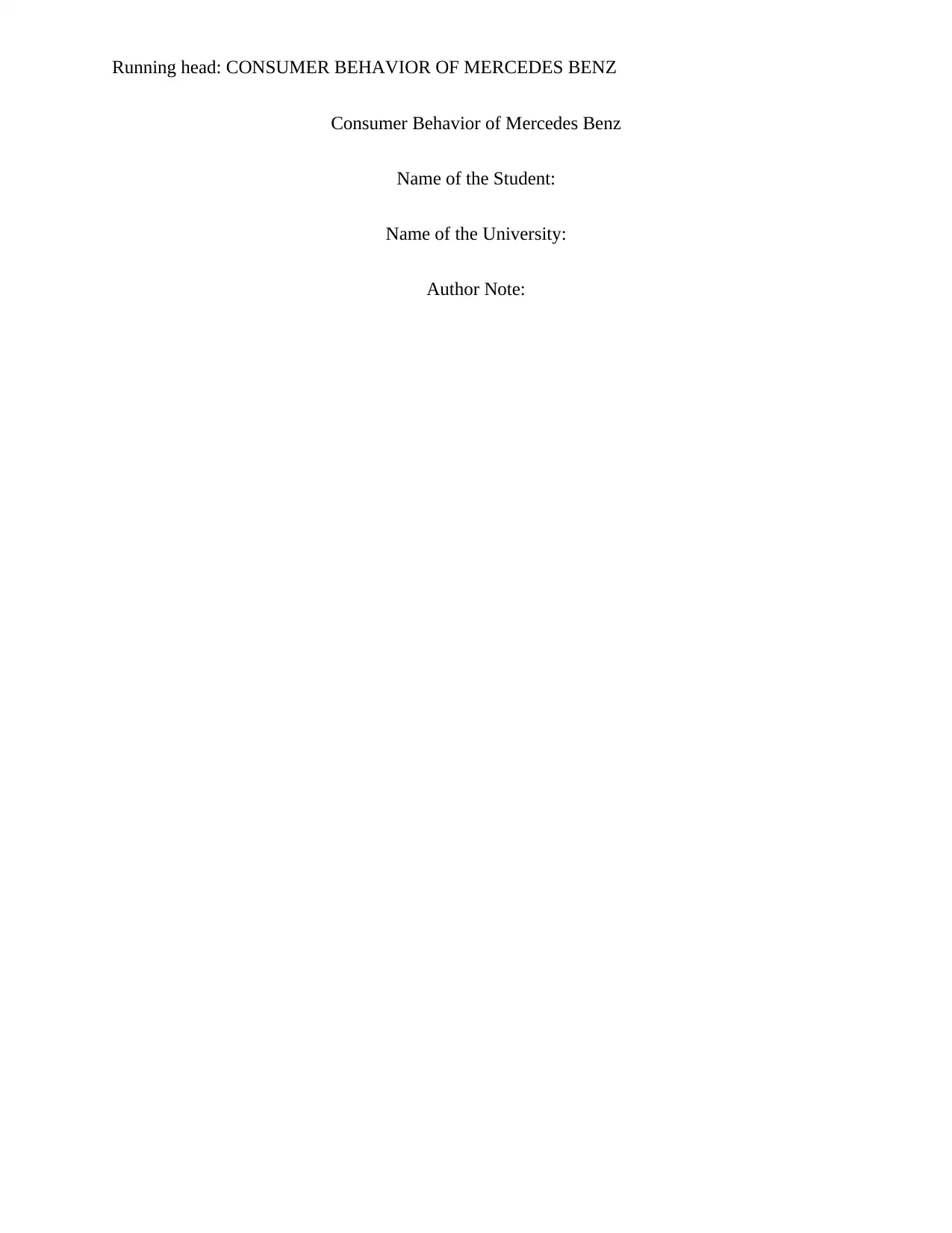
Running head: CONSUMER BEHAVIOR OF MERCEDES BENZ
Consumer Behavior of Mercedes Benz
Name of the Student:
Name of the University:
Author Note:
Consumer Behavior of Mercedes Benz
Name of the Student:
Name of the University:
Author Note:
Secure Best Marks with AI Grader
Need help grading? Try our AI Grader for instant feedback on your assignments.
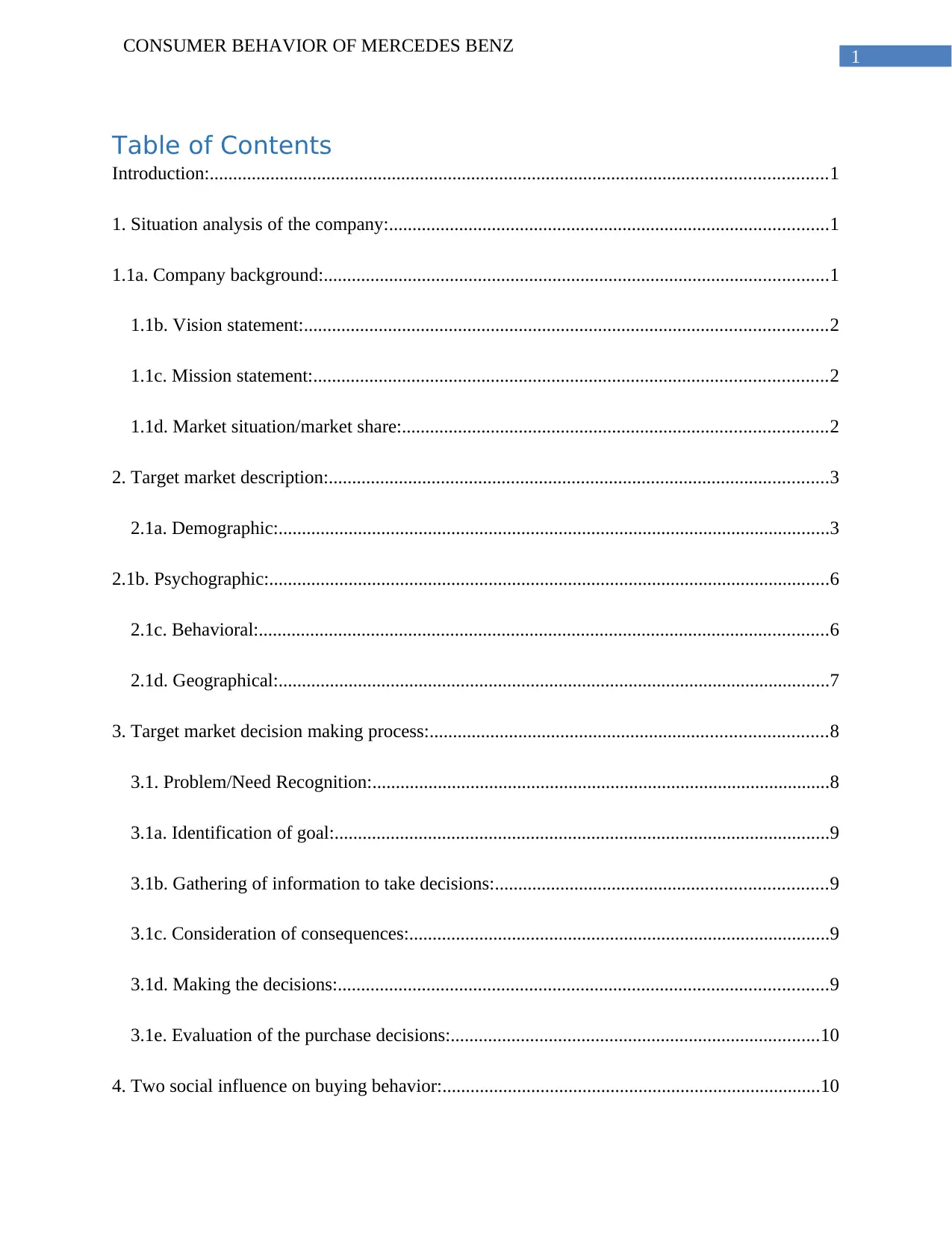
1
CONSUMER BEHAVIOR OF MERCEDES BENZ
Table of Contents
Introduction:....................................................................................................................................1
1. Situation analysis of the company:..............................................................................................1
1.1a. Company background:............................................................................................................1
1.1b. Vision statement:................................................................................................................2
1.1c. Mission statement:..............................................................................................................2
1.1d. Market situation/market share:...........................................................................................2
2. Target market description:...........................................................................................................3
2.1a. Demographic:......................................................................................................................3
2.1b. Psychographic:........................................................................................................................6
2.1c. Behavioral:..........................................................................................................................6
2.1d. Geographical:......................................................................................................................7
3. Target market decision making process:.....................................................................................8
3.1. Problem/Need Recognition:..................................................................................................8
3.1a. Identification of goal:..........................................................................................................9
3.1b. Gathering of information to take decisions:.......................................................................9
3.1c. Consideration of consequences:..........................................................................................9
3.1d. Making the decisions:.........................................................................................................9
3.1e. Evaluation of the purchase decisions:...............................................................................10
4. Two social influence on buying behavior:.................................................................................10
CONSUMER BEHAVIOR OF MERCEDES BENZ
Table of Contents
Introduction:....................................................................................................................................1
1. Situation analysis of the company:..............................................................................................1
1.1a. Company background:............................................................................................................1
1.1b. Vision statement:................................................................................................................2
1.1c. Mission statement:..............................................................................................................2
1.1d. Market situation/market share:...........................................................................................2
2. Target market description:...........................................................................................................3
2.1a. Demographic:......................................................................................................................3
2.1b. Psychographic:........................................................................................................................6
2.1c. Behavioral:..........................................................................................................................6
2.1d. Geographical:......................................................................................................................7
3. Target market decision making process:.....................................................................................8
3.1. Problem/Need Recognition:..................................................................................................8
3.1a. Identification of goal:..........................................................................................................9
3.1b. Gathering of information to take decisions:.......................................................................9
3.1c. Consideration of consequences:..........................................................................................9
3.1d. Making the decisions:.........................................................................................................9
3.1e. Evaluation of the purchase decisions:...............................................................................10
4. Two social influence on buying behavior:.................................................................................10
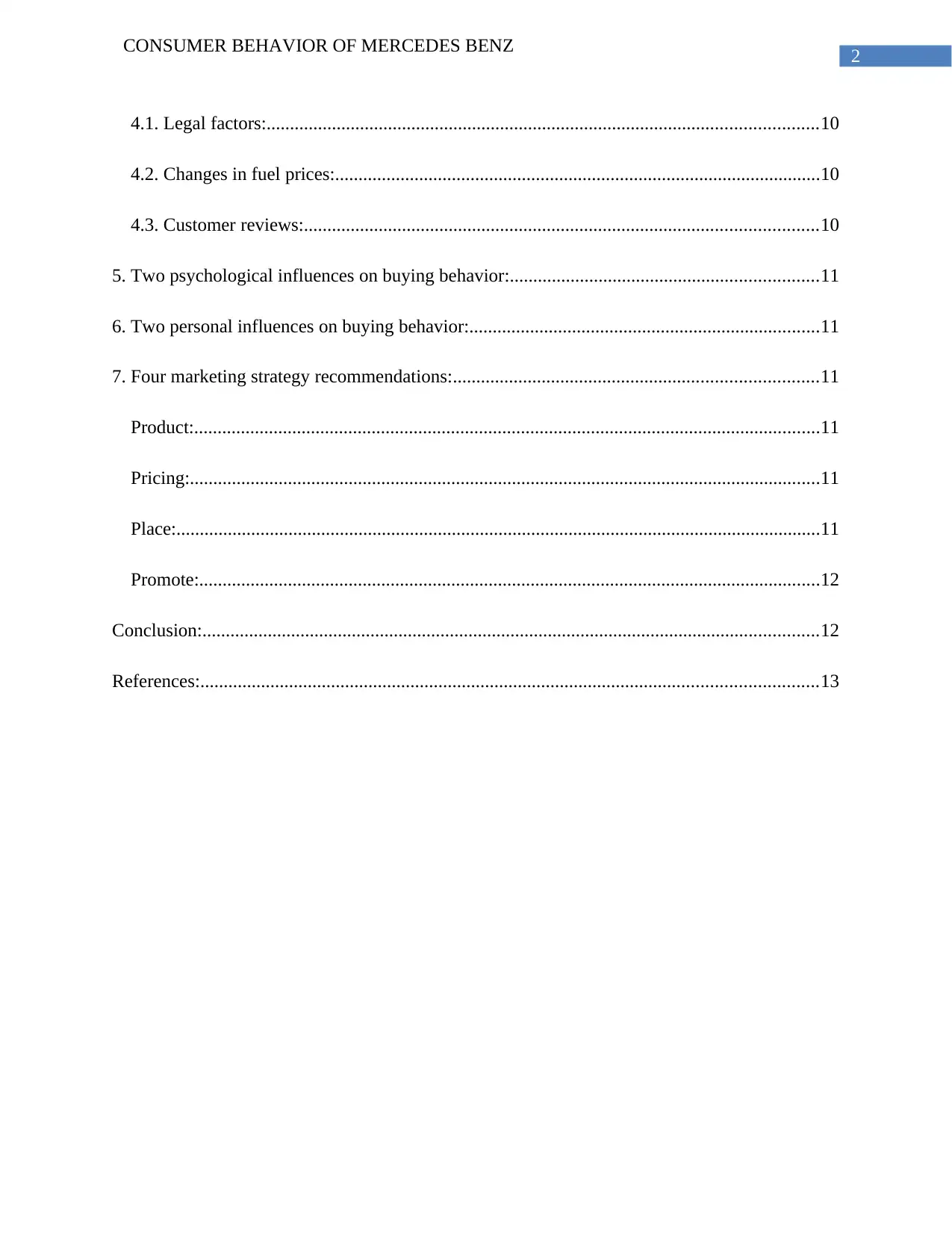
2
CONSUMER BEHAVIOR OF MERCEDES BENZ
4.1. Legal factors:......................................................................................................................10
4.2. Changes in fuel prices:........................................................................................................10
4.3. Customer reviews:..............................................................................................................10
5. Two psychological influences on buying behavior:..................................................................11
6. Two personal influences on buying behavior:...........................................................................11
7. Four marketing strategy recommendations:..............................................................................11
Product:......................................................................................................................................11
Pricing:.......................................................................................................................................11
Place:..........................................................................................................................................11
Promote:.....................................................................................................................................12
Conclusion:....................................................................................................................................12
References:....................................................................................................................................13
CONSUMER BEHAVIOR OF MERCEDES BENZ
4.1. Legal factors:......................................................................................................................10
4.2. Changes in fuel prices:........................................................................................................10
4.3. Customer reviews:..............................................................................................................10
5. Two psychological influences on buying behavior:..................................................................11
6. Two personal influences on buying behavior:...........................................................................11
7. Four marketing strategy recommendations:..............................................................................11
Product:......................................................................................................................................11
Pricing:.......................................................................................................................................11
Place:..........................................................................................................................................11
Promote:.....................................................................................................................................12
Conclusion:....................................................................................................................................12
References:....................................................................................................................................13
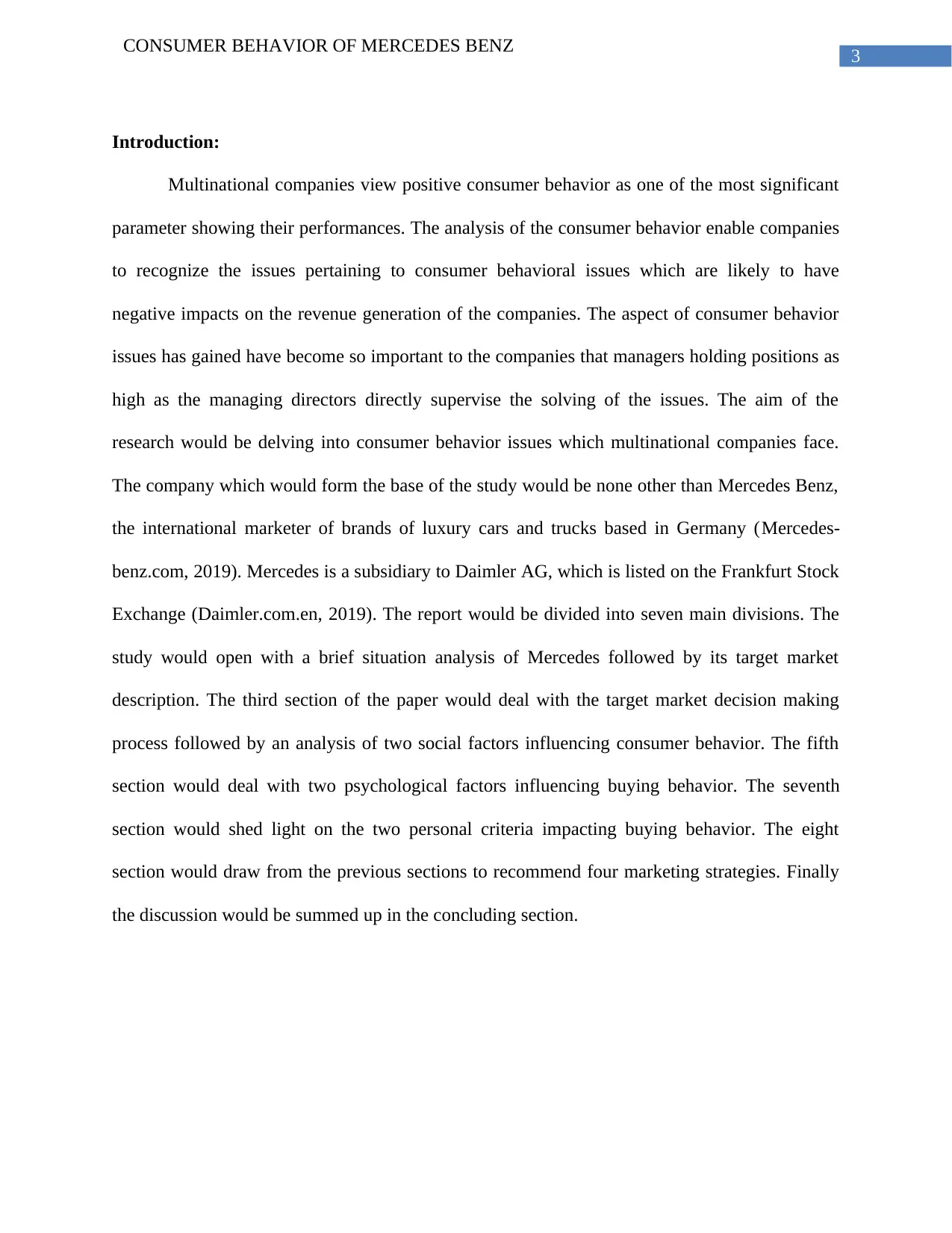
3
CONSUMER BEHAVIOR OF MERCEDES BENZ
Introduction:
Multinational companies view positive consumer behavior as one of the most significant
parameter showing their performances. The analysis of the consumer behavior enable companies
to recognize the issues pertaining to consumer behavioral issues which are likely to have
negative impacts on the revenue generation of the companies. The aspect of consumer behavior
issues has gained have become so important to the companies that managers holding positions as
high as the managing directors directly supervise the solving of the issues. The aim of the
research would be delving into consumer behavior issues which multinational companies face.
The company which would form the base of the study would be none other than Mercedes Benz,
the international marketer of brands of luxury cars and trucks based in Germany (Mercedes-
benz.com, 2019). Mercedes is a subsidiary to Daimler AG, which is listed on the Frankfurt Stock
Exchange (Daimler.com.en, 2019). The report would be divided into seven main divisions. The
study would open with a brief situation analysis of Mercedes followed by its target market
description. The third section of the paper would deal with the target market decision making
process followed by an analysis of two social factors influencing consumer behavior. The fifth
section would deal with two psychological factors influencing buying behavior. The seventh
section would shed light on the two personal criteria impacting buying behavior. The eight
section would draw from the previous sections to recommend four marketing strategies. Finally
the discussion would be summed up in the concluding section.
CONSUMER BEHAVIOR OF MERCEDES BENZ
Introduction:
Multinational companies view positive consumer behavior as one of the most significant
parameter showing their performances. The analysis of the consumer behavior enable companies
to recognize the issues pertaining to consumer behavioral issues which are likely to have
negative impacts on the revenue generation of the companies. The aspect of consumer behavior
issues has gained have become so important to the companies that managers holding positions as
high as the managing directors directly supervise the solving of the issues. The aim of the
research would be delving into consumer behavior issues which multinational companies face.
The company which would form the base of the study would be none other than Mercedes Benz,
the international marketer of brands of luxury cars and trucks based in Germany (Mercedes-
benz.com, 2019). Mercedes is a subsidiary to Daimler AG, which is listed on the Frankfurt Stock
Exchange (Daimler.com.en, 2019). The report would be divided into seven main divisions. The
study would open with a brief situation analysis of Mercedes followed by its target market
description. The third section of the paper would deal with the target market decision making
process followed by an analysis of two social factors influencing consumer behavior. The fifth
section would deal with two psychological factors influencing buying behavior. The seventh
section would shed light on the two personal criteria impacting buying behavior. The eight
section would draw from the previous sections to recommend four marketing strategies. Finally
the discussion would be summed up in the concluding section.
Secure Best Marks with AI Grader
Need help grading? Try our AI Grader for instant feedback on your assignments.
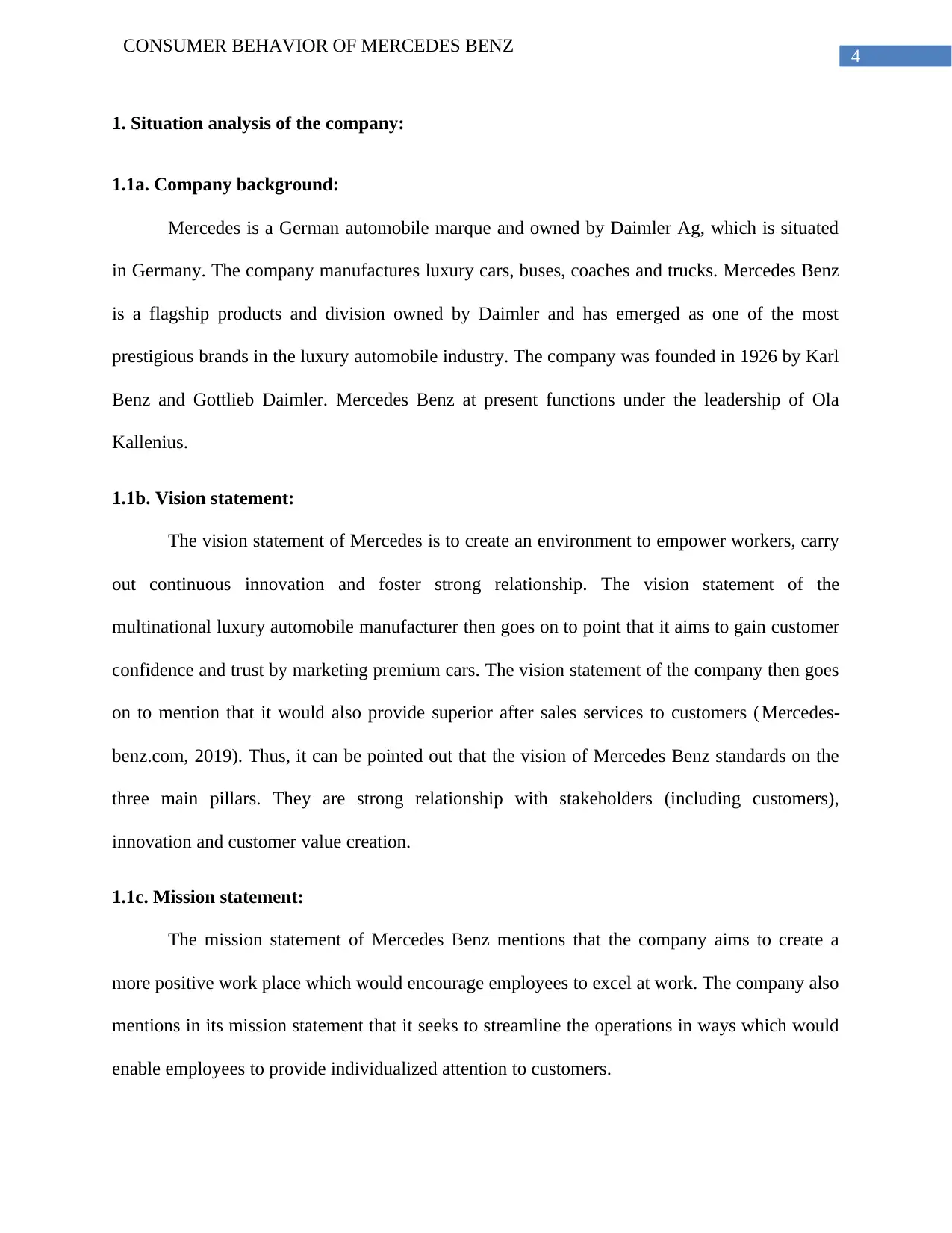
4
CONSUMER BEHAVIOR OF MERCEDES BENZ
1. Situation analysis of the company:
1.1a. Company background:
Mercedes is a German automobile marque and owned by Daimler Ag, which is situated
in Germany. The company manufactures luxury cars, buses, coaches and trucks. Mercedes Benz
is a flagship products and division owned by Daimler and has emerged as one of the most
prestigious brands in the luxury automobile industry. The company was founded in 1926 by Karl
Benz and Gottlieb Daimler. Mercedes Benz at present functions under the leadership of Ola
Kallenius.
1.1b. Vision statement:
The vision statement of Mercedes is to create an environment to empower workers, carry
out continuous innovation and foster strong relationship. The vision statement of the
multinational luxury automobile manufacturer then goes on to point that it aims to gain customer
confidence and trust by marketing premium cars. The vision statement of the company then goes
on to mention that it would also provide superior after sales services to customers (Mercedes-
benz.com, 2019). Thus, it can be pointed out that the vision of Mercedes Benz standards on the
three main pillars. They are strong relationship with stakeholders (including customers),
innovation and customer value creation.
1.1c. Mission statement:
The mission statement of Mercedes Benz mentions that the company aims to create a
more positive work place which would encourage employees to excel at work. The company also
mentions in its mission statement that it seeks to streamline the operations in ways which would
enable employees to provide individualized attention to customers.
CONSUMER BEHAVIOR OF MERCEDES BENZ
1. Situation analysis of the company:
1.1a. Company background:
Mercedes is a German automobile marque and owned by Daimler Ag, which is situated
in Germany. The company manufactures luxury cars, buses, coaches and trucks. Mercedes Benz
is a flagship products and division owned by Daimler and has emerged as one of the most
prestigious brands in the luxury automobile industry. The company was founded in 1926 by Karl
Benz and Gottlieb Daimler. Mercedes Benz at present functions under the leadership of Ola
Kallenius.
1.1b. Vision statement:
The vision statement of Mercedes is to create an environment to empower workers, carry
out continuous innovation and foster strong relationship. The vision statement of the
multinational luxury automobile manufacturer then goes on to point that it aims to gain customer
confidence and trust by marketing premium cars. The vision statement of the company then goes
on to mention that it would also provide superior after sales services to customers (Mercedes-
benz.com, 2019). Thus, it can be pointed out that the vision of Mercedes Benz standards on the
three main pillars. They are strong relationship with stakeholders (including customers),
innovation and customer value creation.
1.1c. Mission statement:
The mission statement of Mercedes Benz mentions that the company aims to create a
more positive work place which would encourage employees to excel at work. The company also
mentions in its mission statement that it seeks to streamline the operations in ways which would
enable employees to provide individualized attention to customers.
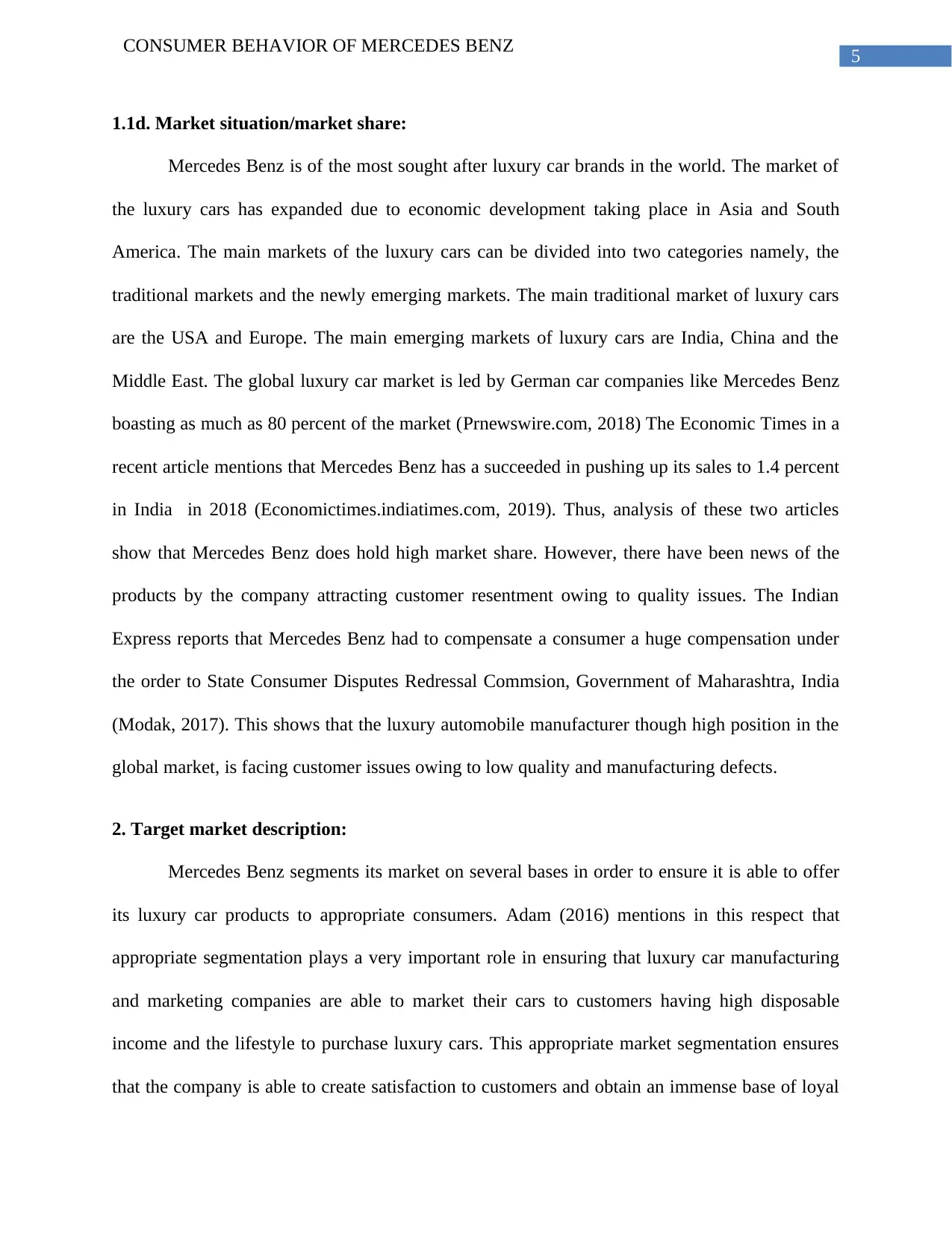
5
CONSUMER BEHAVIOR OF MERCEDES BENZ
1.1d. Market situation/market share:
Mercedes Benz is of the most sought after luxury car brands in the world. The market of
the luxury cars has expanded due to economic development taking place in Asia and South
America. The main markets of the luxury cars can be divided into two categories namely, the
traditional markets and the newly emerging markets. The main traditional market of luxury cars
are the USA and Europe. The main emerging markets of luxury cars are India, China and the
Middle East. The global luxury car market is led by German car companies like Mercedes Benz
boasting as much as 80 percent of the market (Prnewswire.com, 2018) The Economic Times in a
recent article mentions that Mercedes Benz has a succeeded in pushing up its sales to 1.4 percent
in India in 2018 (Economictimes.indiatimes.com, 2019). Thus, analysis of these two articles
show that Mercedes Benz does hold high market share. However, there have been news of the
products by the company attracting customer resentment owing to quality issues. The Indian
Express reports that Mercedes Benz had to compensate a consumer a huge compensation under
the order to State Consumer Disputes Redressal Commsion, Government of Maharashtra, India
(Modak, 2017). This shows that the luxury automobile manufacturer though high position in the
global market, is facing customer issues owing to low quality and manufacturing defects.
2. Target market description:
Mercedes Benz segments its market on several bases in order to ensure it is able to offer
its luxury car products to appropriate consumers. Adam (2016) mentions in this respect that
appropriate segmentation plays a very important role in ensuring that luxury car manufacturing
and marketing companies are able to market their cars to customers having high disposable
income and the lifestyle to purchase luxury cars. This appropriate market segmentation ensures
that the company is able to create satisfaction to customers and obtain an immense base of loyal
CONSUMER BEHAVIOR OF MERCEDES BENZ
1.1d. Market situation/market share:
Mercedes Benz is of the most sought after luxury car brands in the world. The market of
the luxury cars has expanded due to economic development taking place in Asia and South
America. The main markets of the luxury cars can be divided into two categories namely, the
traditional markets and the newly emerging markets. The main traditional market of luxury cars
are the USA and Europe. The main emerging markets of luxury cars are India, China and the
Middle East. The global luxury car market is led by German car companies like Mercedes Benz
boasting as much as 80 percent of the market (Prnewswire.com, 2018) The Economic Times in a
recent article mentions that Mercedes Benz has a succeeded in pushing up its sales to 1.4 percent
in India in 2018 (Economictimes.indiatimes.com, 2019). Thus, analysis of these two articles
show that Mercedes Benz does hold high market share. However, there have been news of the
products by the company attracting customer resentment owing to quality issues. The Indian
Express reports that Mercedes Benz had to compensate a consumer a huge compensation under
the order to State Consumer Disputes Redressal Commsion, Government of Maharashtra, India
(Modak, 2017). This shows that the luxury automobile manufacturer though high position in the
global market, is facing customer issues owing to low quality and manufacturing defects.
2. Target market description:
Mercedes Benz segments its market on several bases in order to ensure it is able to offer
its luxury car products to appropriate consumers. Adam (2016) mentions in this respect that
appropriate segmentation plays a very important role in ensuring that luxury car manufacturing
and marketing companies are able to market their cars to customers having high disposable
income and the lifestyle to purchase luxury cars. This appropriate market segmentation ensures
that the company is able to create satisfaction to customers and obtain an immense base of loyal
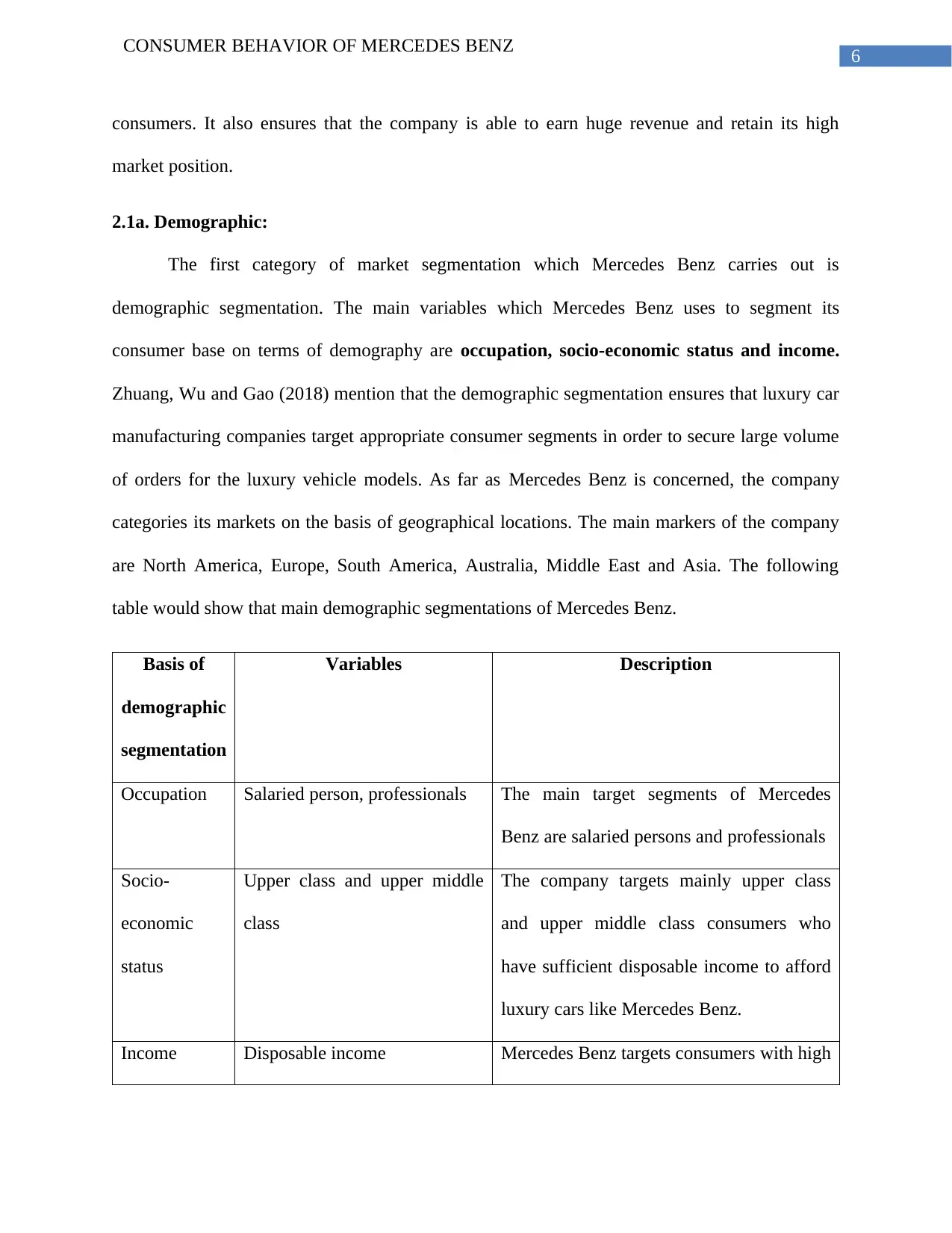
6
CONSUMER BEHAVIOR OF MERCEDES BENZ
consumers. It also ensures that the company is able to earn huge revenue and retain its high
market position.
2.1a. Demographic:
The first category of market segmentation which Mercedes Benz carries out is
demographic segmentation. The main variables which Mercedes Benz uses to segment its
consumer base on terms of demography are occupation, socio-economic status and income.
Zhuang, Wu and Gao (2018) mention that the demographic segmentation ensures that luxury car
manufacturing companies target appropriate consumer segments in order to secure large volume
of orders for the luxury vehicle models. As far as Mercedes Benz is concerned, the company
categories its markets on the basis of geographical locations. The main markers of the company
are North America, Europe, South America, Australia, Middle East and Asia. The following
table would show that main demographic segmentations of Mercedes Benz.
Basis of
demographic
segmentation
Variables Description
Occupation Salaried person, professionals The main target segments of Mercedes
Benz are salaried persons and professionals
Socio-
economic
status
Upper class and upper middle
class
The company targets mainly upper class
and upper middle class consumers who
have sufficient disposable income to afford
luxury cars like Mercedes Benz.
Income Disposable income Mercedes Benz targets consumers with high
CONSUMER BEHAVIOR OF MERCEDES BENZ
consumers. It also ensures that the company is able to earn huge revenue and retain its high
market position.
2.1a. Demographic:
The first category of market segmentation which Mercedes Benz carries out is
demographic segmentation. The main variables which Mercedes Benz uses to segment its
consumer base on terms of demography are occupation, socio-economic status and income.
Zhuang, Wu and Gao (2018) mention that the demographic segmentation ensures that luxury car
manufacturing companies target appropriate consumer segments in order to secure large volume
of orders for the luxury vehicle models. As far as Mercedes Benz is concerned, the company
categories its markets on the basis of geographical locations. The main markers of the company
are North America, Europe, South America, Australia, Middle East and Asia. The following
table would show that main demographic segmentations of Mercedes Benz.
Basis of
demographic
segmentation
Variables Description
Occupation Salaried person, professionals The main target segments of Mercedes
Benz are salaried persons and professionals
Socio-
economic
status
Upper class and upper middle
class
The company targets mainly upper class
and upper middle class consumers who
have sufficient disposable income to afford
luxury cars like Mercedes Benz.
Income Disposable income Mercedes Benz targets consumers with high
Paraphrase This Document
Need a fresh take? Get an instant paraphrase of this document with our AI Paraphraser
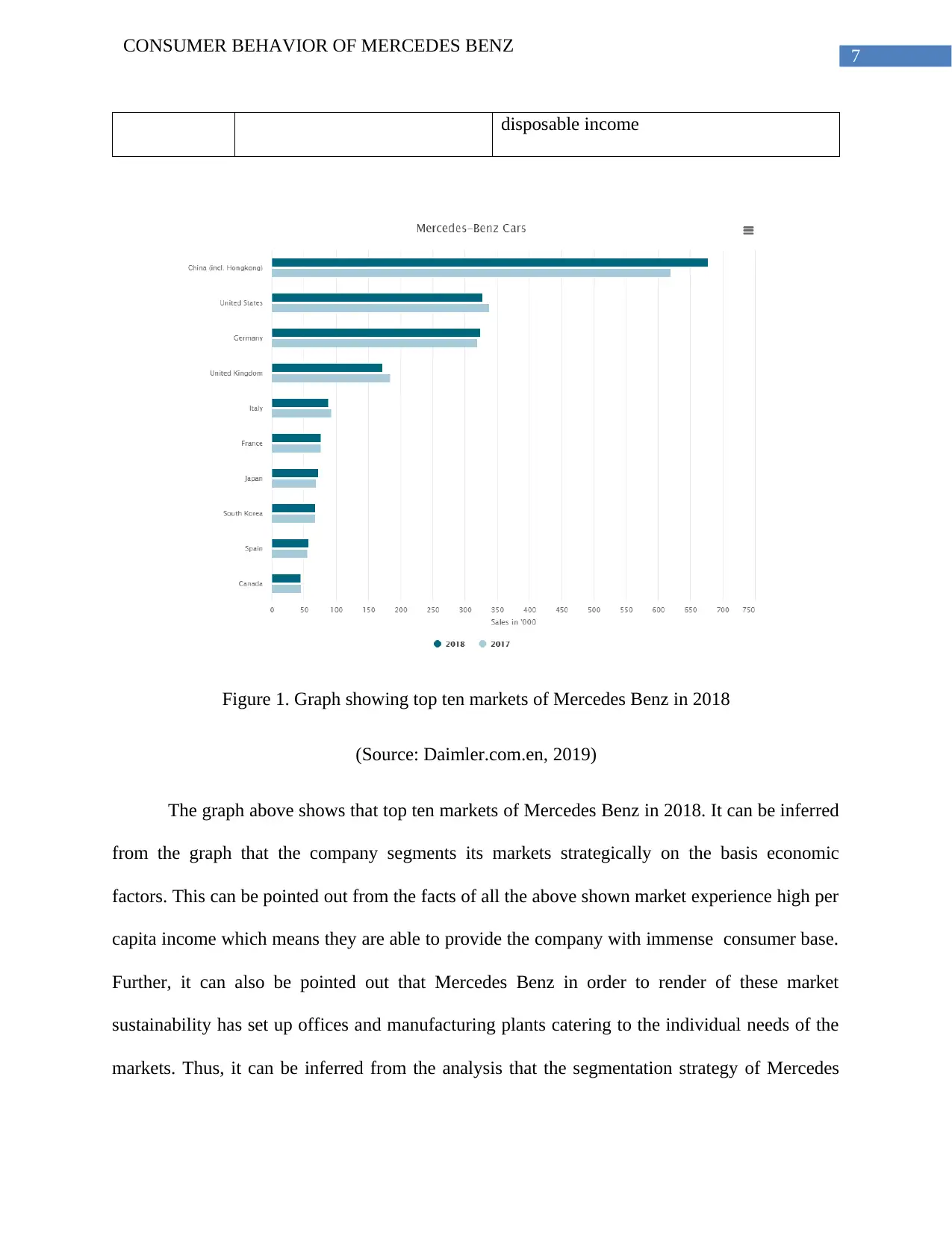
7
CONSUMER BEHAVIOR OF MERCEDES BENZ
disposable income
Figure 1. Graph showing top ten markets of Mercedes Benz in 2018
(Source: Daimler.com.en, 2019)
The graph above shows that top ten markets of Mercedes Benz in 2018. It can be inferred
from the graph that the company segments its markets strategically on the basis economic
factors. This can be pointed out from the facts of all the above shown market experience high per
capita income which means they are able to provide the company with immense consumer base.
Further, it can also be pointed out that Mercedes Benz in order to render of these market
sustainability has set up offices and manufacturing plants catering to the individual needs of the
markets. Thus, it can be inferred from the analysis that the segmentation strategy of Mercedes
CONSUMER BEHAVIOR OF MERCEDES BENZ
disposable income
Figure 1. Graph showing top ten markets of Mercedes Benz in 2018
(Source: Daimler.com.en, 2019)
The graph above shows that top ten markets of Mercedes Benz in 2018. It can be inferred
from the graph that the company segments its markets strategically on the basis economic
factors. This can be pointed out from the facts of all the above shown market experience high per
capita income which means they are able to provide the company with immense consumer base.
Further, it can also be pointed out that Mercedes Benz in order to render of these market
sustainability has set up offices and manufacturing plants catering to the individual needs of the
markets. Thus, it can be inferred from the analysis that the segmentation strategy of Mercedes
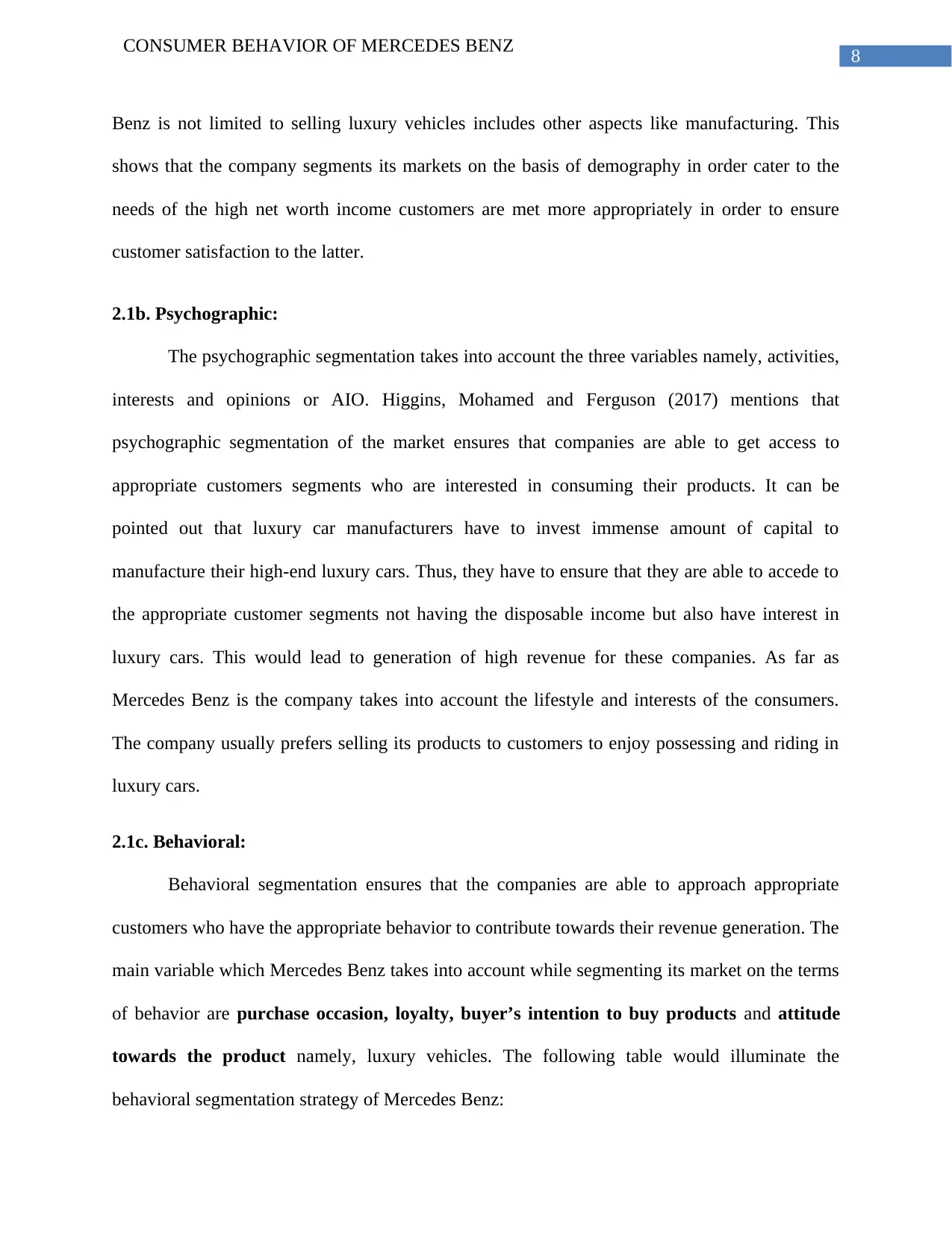
8
CONSUMER BEHAVIOR OF MERCEDES BENZ
Benz is not limited to selling luxury vehicles includes other aspects like manufacturing. This
shows that the company segments its markets on the basis of demography in order cater to the
needs of the high net worth income customers are met more appropriately in order to ensure
customer satisfaction to the latter.
2.1b. Psychographic:
The psychographic segmentation takes into account the three variables namely, activities,
interests and opinions or AIO. Higgins, Mohamed and Ferguson (2017) mentions that
psychographic segmentation of the market ensures that companies are able to get access to
appropriate customers segments who are interested in consuming their products. It can be
pointed out that luxury car manufacturers have to invest immense amount of capital to
manufacture their high-end luxury cars. Thus, they have to ensure that they are able to accede to
the appropriate customer segments not having the disposable income but also have interest in
luxury cars. This would lead to generation of high revenue for these companies. As far as
Mercedes Benz is the company takes into account the lifestyle and interests of the consumers.
The company usually prefers selling its products to customers to enjoy possessing and riding in
luxury cars.
2.1c. Behavioral:
Behavioral segmentation ensures that the companies are able to approach appropriate
customers who have the appropriate behavior to contribute towards their revenue generation. The
main variable which Mercedes Benz takes into account while segmenting its market on the terms
of behavior are purchase occasion, loyalty, buyer’s intention to buy products and attitude
towards the product namely, luxury vehicles. The following table would illuminate the
behavioral segmentation strategy of Mercedes Benz:
CONSUMER BEHAVIOR OF MERCEDES BENZ
Benz is not limited to selling luxury vehicles includes other aspects like manufacturing. This
shows that the company segments its markets on the basis of demography in order cater to the
needs of the high net worth income customers are met more appropriately in order to ensure
customer satisfaction to the latter.
2.1b. Psychographic:
The psychographic segmentation takes into account the three variables namely, activities,
interests and opinions or AIO. Higgins, Mohamed and Ferguson (2017) mentions that
psychographic segmentation of the market ensures that companies are able to get access to
appropriate customers segments who are interested in consuming their products. It can be
pointed out that luxury car manufacturers have to invest immense amount of capital to
manufacture their high-end luxury cars. Thus, they have to ensure that they are able to accede to
the appropriate customer segments not having the disposable income but also have interest in
luxury cars. This would lead to generation of high revenue for these companies. As far as
Mercedes Benz is the company takes into account the lifestyle and interests of the consumers.
The company usually prefers selling its products to customers to enjoy possessing and riding in
luxury cars.
2.1c. Behavioral:
Behavioral segmentation ensures that the companies are able to approach appropriate
customers who have the appropriate behavior to contribute towards their revenue generation. The
main variable which Mercedes Benz takes into account while segmenting its market on the terms
of behavior are purchase occasion, loyalty, buyer’s intention to buy products and attitude
towards the product namely, luxury vehicles. The following table would illuminate the
behavioral segmentation strategy of Mercedes Benz:

9
CONSUMER BEHAVIOR OF MERCEDES BENZ
CONSUMER BEHAVIOR OF MERCEDES BENZ
Secure Best Marks with AI Grader
Need help grading? Try our AI Grader for instant feedback on your assignments.
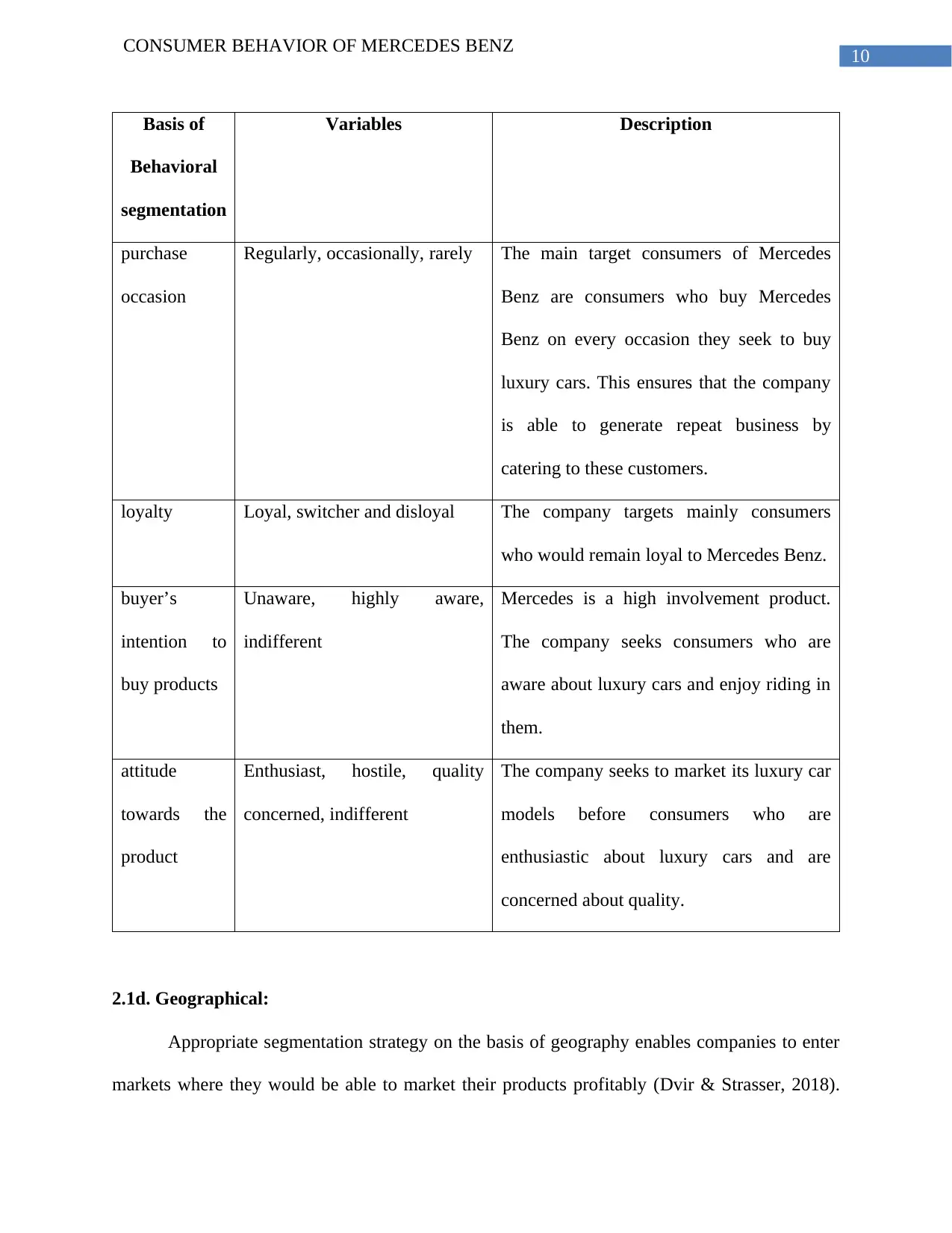
10
CONSUMER BEHAVIOR OF MERCEDES BENZ
Basis of
Behavioral
segmentation
Variables Description
purchase
occasion
Regularly, occasionally, rarely The main target consumers of Mercedes
Benz are consumers who buy Mercedes
Benz on every occasion they seek to buy
luxury cars. This ensures that the company
is able to generate repeat business by
catering to these customers.
loyalty Loyal, switcher and disloyal The company targets mainly consumers
who would remain loyal to Mercedes Benz.
buyer’s
intention to
buy products
Unaware, highly aware,
indifferent
Mercedes is a high involvement product.
The company seeks consumers who are
aware about luxury cars and enjoy riding in
them.
attitude
towards the
product
Enthusiast, hostile, quality
concerned, indifferent
The company seeks to market its luxury car
models before consumers who are
enthusiastic about luxury cars and are
concerned about quality.
2.1d. Geographical:
Appropriate segmentation strategy on the basis of geography enables companies to enter
markets where they would be able to market their products profitably (Dvir & Strasser, 2018).
CONSUMER BEHAVIOR OF MERCEDES BENZ
Basis of
Behavioral
segmentation
Variables Description
purchase
occasion
Regularly, occasionally, rarely The main target consumers of Mercedes
Benz are consumers who buy Mercedes
Benz on every occasion they seek to buy
luxury cars. This ensures that the company
is able to generate repeat business by
catering to these customers.
loyalty Loyal, switcher and disloyal The company targets mainly consumers
who would remain loyal to Mercedes Benz.
buyer’s
intention to
buy products
Unaware, highly aware,
indifferent
Mercedes is a high involvement product.
The company seeks consumers who are
aware about luxury cars and enjoy riding in
them.
attitude
towards the
product
Enthusiast, hostile, quality
concerned, indifferent
The company seeks to market its luxury car
models before consumers who are
enthusiastic about luxury cars and are
concerned about quality.
2.1d. Geographical:
Appropriate segmentation strategy on the basis of geography enables companies to enter
markets where they would be able to market their products profitably (Dvir & Strasser, 2018).

11
CONSUMER BEHAVIOR OF MERCEDES BENZ
This fact holds even more applicable for high involvement goods like luxury cars. Mercedes
Benz segments like market on the bases of country, region, population and urbanization level.
As far as the market segmentation on the basis of country is concerned, Mercedes Benz segments
its market into developed and emerging economies. The main develop economies which the
company targets are the US and the EU nations. The emerging markets consists of mainly Asian
markets like India and China. The company targets mainly regions with high density of upper
class customers like metropolitan cities. As far as the market segmentation in the line of
population is concerned, the company targets markets with high density of population. Zhechev
and Stanimiro (2017) point out that markets with high population enable multinational
companies to accede to a larger population of appropriate consumers. It can be pointed out that
this fact holds very true for Mercedes Benz because the company caters to high income
consumer base. It can also be pointed out that the most of the present markets of the company
like the US and the EU nations have extremely high population which increases the probability
of the company to reach HNI customers in higher numbers. The company prefers to market its
products in cities where the people have interests in riding in high end luxury cars.
3. Target market decision making process:
Mercedes Benz at the management levels form strategies to market its high-end cars in
the target markets like the USA and China. The management conducts extensive macroeconomic
analysis to collect sufficient market data on the variables to take decisions regarding the
following:
CONSUMER BEHAVIOR OF MERCEDES BENZ
This fact holds even more applicable for high involvement goods like luxury cars. Mercedes
Benz segments like market on the bases of country, region, population and urbanization level.
As far as the market segmentation on the basis of country is concerned, Mercedes Benz segments
its market into developed and emerging economies. The main develop economies which the
company targets are the US and the EU nations. The emerging markets consists of mainly Asian
markets like India and China. The company targets mainly regions with high density of upper
class customers like metropolitan cities. As far as the market segmentation in the line of
population is concerned, the company targets markets with high density of population. Zhechev
and Stanimiro (2017) point out that markets with high population enable multinational
companies to accede to a larger population of appropriate consumers. It can be pointed out that
this fact holds very true for Mercedes Benz because the company caters to high income
consumer base. It can also be pointed out that the most of the present markets of the company
like the US and the EU nations have extremely high population which increases the probability
of the company to reach HNI customers in higher numbers. The company prefers to market its
products in cities where the people have interests in riding in high end luxury cars.
3. Target market decision making process:
Mercedes Benz at the management levels form strategies to market its high-end cars in
the target markets like the USA and China. The management conducts extensive macroeconomic
analysis to collect sufficient market data on the variables to take decisions regarding the
following:
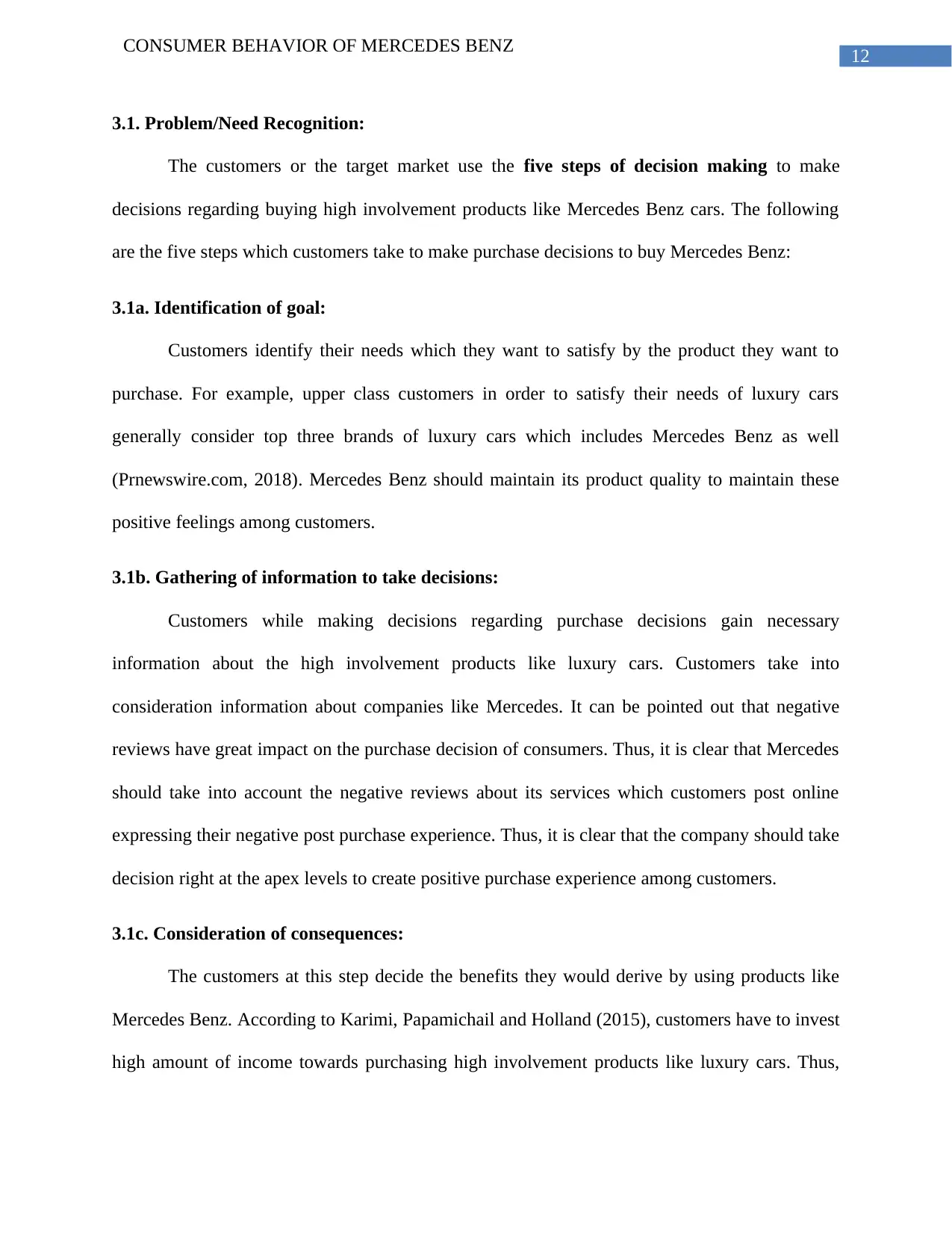
12
CONSUMER BEHAVIOR OF MERCEDES BENZ
3.1. Problem/Need Recognition:
The customers or the target market use the five steps of decision making to make
decisions regarding buying high involvement products like Mercedes Benz cars. The following
are the five steps which customers take to make purchase decisions to buy Mercedes Benz:
3.1a. Identification of goal:
Customers identify their needs which they want to satisfy by the product they want to
purchase. For example, upper class customers in order to satisfy their needs of luxury cars
generally consider top three brands of luxury cars which includes Mercedes Benz as well
(Prnewswire.com, 2018). Mercedes Benz should maintain its product quality to maintain these
positive feelings among customers.
3.1b. Gathering of information to take decisions:
Customers while making decisions regarding purchase decisions gain necessary
information about the high involvement products like luxury cars. Customers take into
consideration information about companies like Mercedes. It can be pointed out that negative
reviews have great impact on the purchase decision of consumers. Thus, it is clear that Mercedes
should take into account the negative reviews about its services which customers post online
expressing their negative post purchase experience. Thus, it is clear that the company should take
decision right at the apex levels to create positive purchase experience among customers.
3.1c. Consideration of consequences:
The customers at this step decide the benefits they would derive by using products like
Mercedes Benz. According to Karimi, Papamichail and Holland (2015), customers have to invest
high amount of income towards purchasing high involvement products like luxury cars. Thus,
CONSUMER BEHAVIOR OF MERCEDES BENZ
3.1. Problem/Need Recognition:
The customers or the target market use the five steps of decision making to make
decisions regarding buying high involvement products like Mercedes Benz cars. The following
are the five steps which customers take to make purchase decisions to buy Mercedes Benz:
3.1a. Identification of goal:
Customers identify their needs which they want to satisfy by the product they want to
purchase. For example, upper class customers in order to satisfy their needs of luxury cars
generally consider top three brands of luxury cars which includes Mercedes Benz as well
(Prnewswire.com, 2018). Mercedes Benz should maintain its product quality to maintain these
positive feelings among customers.
3.1b. Gathering of information to take decisions:
Customers while making decisions regarding purchase decisions gain necessary
information about the high involvement products like luxury cars. Customers take into
consideration information about companies like Mercedes. It can be pointed out that negative
reviews have great impact on the purchase decision of consumers. Thus, it is clear that Mercedes
should take into account the negative reviews about its services which customers post online
expressing their negative post purchase experience. Thus, it is clear that the company should take
decision right at the apex levels to create positive purchase experience among customers.
3.1c. Consideration of consequences:
The customers at this step decide the benefits they would derive by using products like
Mercedes Benz. According to Karimi, Papamichail and Holland (2015), customers have to invest
high amount of income towards purchasing high involvement products like luxury cars. Thus,
Paraphrase This Document
Need a fresh take? Get an instant paraphrase of this document with our AI Paraphraser
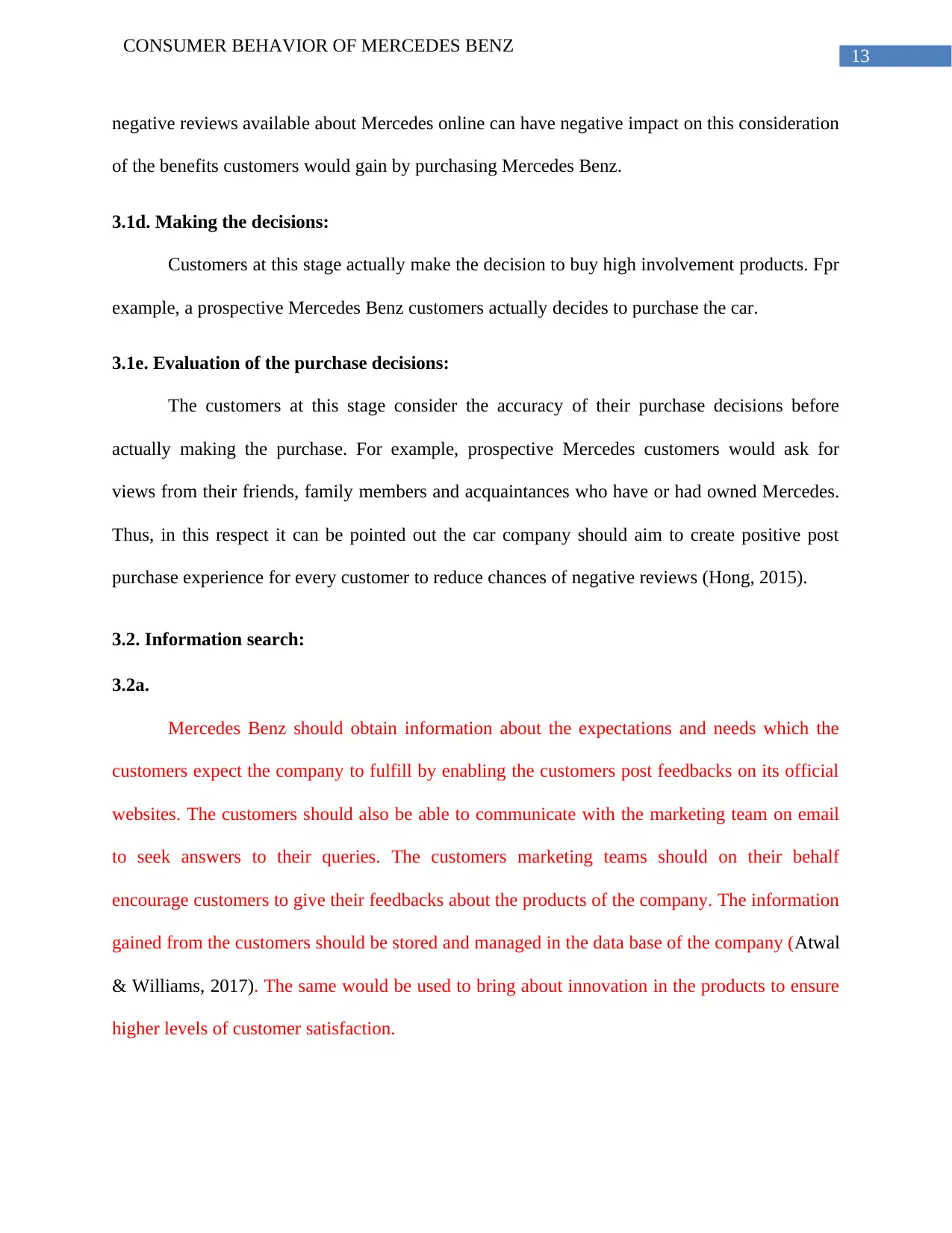
13
CONSUMER BEHAVIOR OF MERCEDES BENZ
negative reviews available about Mercedes online can have negative impact on this consideration
of the benefits customers would gain by purchasing Mercedes Benz.
3.1d. Making the decisions:
Customers at this stage actually make the decision to buy high involvement products. Fpr
example, a prospective Mercedes Benz customers actually decides to purchase the car.
3.1e. Evaluation of the purchase decisions:
The customers at this stage consider the accuracy of their purchase decisions before
actually making the purchase. For example, prospective Mercedes customers would ask for
views from their friends, family members and acquaintances who have or had owned Mercedes.
Thus, in this respect it can be pointed out the car company should aim to create positive post
purchase experience for every customer to reduce chances of negative reviews (Hong, 2015).
3.2. Information search:
3.2a.
Mercedes Benz should obtain information about the expectations and needs which the
customers expect the company to fulfill by enabling the customers post feedbacks on its official
websites. The customers should also be able to communicate with the marketing team on email
to seek answers to their queries. The customers marketing teams should on their behalf
encourage customers to give their feedbacks about the products of the company. The information
gained from the customers should be stored and managed in the data base of the company (Atwal
& Williams, 2017). The same would be used to bring about innovation in the products to ensure
higher levels of customer satisfaction.
CONSUMER BEHAVIOR OF MERCEDES BENZ
negative reviews available about Mercedes online can have negative impact on this consideration
of the benefits customers would gain by purchasing Mercedes Benz.
3.1d. Making the decisions:
Customers at this stage actually make the decision to buy high involvement products. Fpr
example, a prospective Mercedes Benz customers actually decides to purchase the car.
3.1e. Evaluation of the purchase decisions:
The customers at this stage consider the accuracy of their purchase decisions before
actually making the purchase. For example, prospective Mercedes customers would ask for
views from their friends, family members and acquaintances who have or had owned Mercedes.
Thus, in this respect it can be pointed out the car company should aim to create positive post
purchase experience for every customer to reduce chances of negative reviews (Hong, 2015).
3.2. Information search:
3.2a.
Mercedes Benz should obtain information about the expectations and needs which the
customers expect the company to fulfill by enabling the customers post feedbacks on its official
websites. The customers should also be able to communicate with the marketing team on email
to seek answers to their queries. The customers marketing teams should on their behalf
encourage customers to give their feedbacks about the products of the company. The information
gained from the customers should be stored and managed in the data base of the company (Atwal
& Williams, 2017). The same would be used to bring about innovation in the products to ensure
higher levels of customer satisfaction.
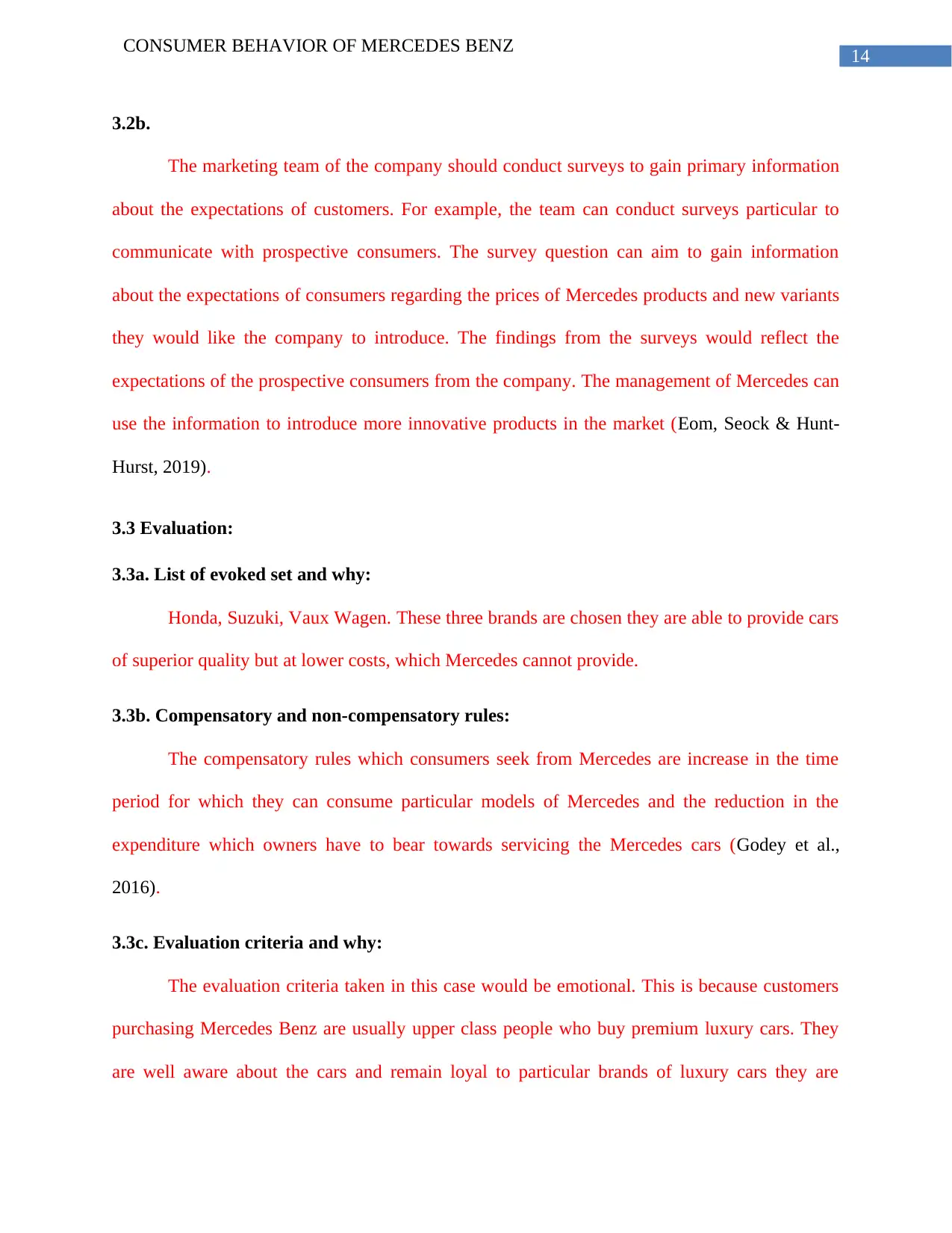
14
CONSUMER BEHAVIOR OF MERCEDES BENZ
3.2b.
The marketing team of the company should conduct surveys to gain primary information
about the expectations of customers. For example, the team can conduct surveys particular to
communicate with prospective consumers. The survey question can aim to gain information
about the expectations of consumers regarding the prices of Mercedes products and new variants
they would like the company to introduce. The findings from the surveys would reflect the
expectations of the prospective consumers from the company. The management of Mercedes can
use the information to introduce more innovative products in the market (Eom, Seock & Hunt-
Hurst, 2019).
3.3 Evaluation:
3.3a. List of evoked set and why:
Honda, Suzuki, Vaux Wagen. These three brands are chosen they are able to provide cars
of superior quality but at lower costs, which Mercedes cannot provide.
3.3b. Compensatory and non-compensatory rules:
The compensatory rules which consumers seek from Mercedes are increase in the time
period for which they can consume particular models of Mercedes and the reduction in the
expenditure which owners have to bear towards servicing the Mercedes cars (Godey et al.,
2016).
3.3c. Evaluation criteria and why:
The evaluation criteria taken in this case would be emotional. This is because customers
purchasing Mercedes Benz are usually upper class people who buy premium luxury cars. They
are well aware about the cars and remain loyal to particular brands of luxury cars they are
CONSUMER BEHAVIOR OF MERCEDES BENZ
3.2b.
The marketing team of the company should conduct surveys to gain primary information
about the expectations of customers. For example, the team can conduct surveys particular to
communicate with prospective consumers. The survey question can aim to gain information
about the expectations of consumers regarding the prices of Mercedes products and new variants
they would like the company to introduce. The findings from the surveys would reflect the
expectations of the prospective consumers from the company. The management of Mercedes can
use the information to introduce more innovative products in the market (Eom, Seock & Hunt-
Hurst, 2019).
3.3 Evaluation:
3.3a. List of evoked set and why:
Honda, Suzuki, Vaux Wagen. These three brands are chosen they are able to provide cars
of superior quality but at lower costs, which Mercedes cannot provide.
3.3b. Compensatory and non-compensatory rules:
The compensatory rules which consumers seek from Mercedes are increase in the time
period for which they can consume particular models of Mercedes and the reduction in the
expenditure which owners have to bear towards servicing the Mercedes cars (Godey et al.,
2016).
3.3c. Evaluation criteria and why:
The evaluation criteria taken in this case would be emotional. This is because customers
purchasing Mercedes Benz are usually upper class people who buy premium luxury cars. They
are well aware about the cars and remain loyal to particular brands of luxury cars they are
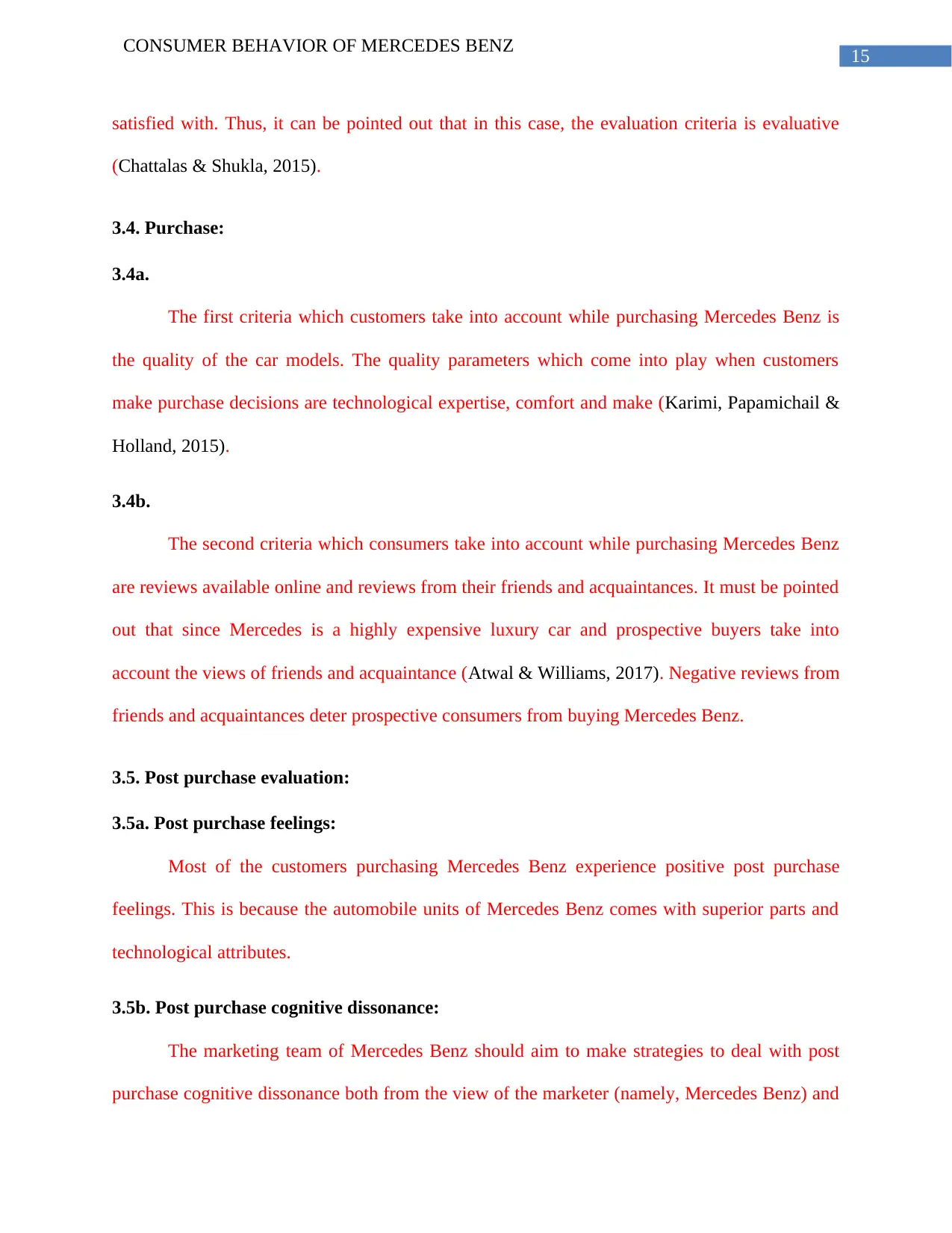
15
CONSUMER BEHAVIOR OF MERCEDES BENZ
satisfied with. Thus, it can be pointed out that in this case, the evaluation criteria is evaluative
(Chattalas & Shukla, 2015).
3.4. Purchase:
3.4a.
The first criteria which customers take into account while purchasing Mercedes Benz is
the quality of the car models. The quality parameters which come into play when customers
make purchase decisions are technological expertise, comfort and make (Karimi, Papamichail &
Holland, 2015).
3.4b.
The second criteria which consumers take into account while purchasing Mercedes Benz
are reviews available online and reviews from their friends and acquaintances. It must be pointed
out that since Mercedes is a highly expensive luxury car and prospective buyers take into
account the views of friends and acquaintance (Atwal & Williams, 2017). Negative reviews from
friends and acquaintances deter prospective consumers from buying Mercedes Benz.
3.5. Post purchase evaluation:
3.5a. Post purchase feelings:
Most of the customers purchasing Mercedes Benz experience positive post purchase
feelings. This is because the automobile units of Mercedes Benz comes with superior parts and
technological attributes.
3.5b. Post purchase cognitive dissonance:
The marketing team of Mercedes Benz should aim to make strategies to deal with post
purchase cognitive dissonance both from the view of the marketer (namely, Mercedes Benz) and
CONSUMER BEHAVIOR OF MERCEDES BENZ
satisfied with. Thus, it can be pointed out that in this case, the evaluation criteria is evaluative
(Chattalas & Shukla, 2015).
3.4. Purchase:
3.4a.
The first criteria which customers take into account while purchasing Mercedes Benz is
the quality of the car models. The quality parameters which come into play when customers
make purchase decisions are technological expertise, comfort and make (Karimi, Papamichail &
Holland, 2015).
3.4b.
The second criteria which consumers take into account while purchasing Mercedes Benz
are reviews available online and reviews from their friends and acquaintances. It must be pointed
out that since Mercedes is a highly expensive luxury car and prospective buyers take into
account the views of friends and acquaintance (Atwal & Williams, 2017). Negative reviews from
friends and acquaintances deter prospective consumers from buying Mercedes Benz.
3.5. Post purchase evaluation:
3.5a. Post purchase feelings:
Most of the customers purchasing Mercedes Benz experience positive post purchase
feelings. This is because the automobile units of Mercedes Benz comes with superior parts and
technological attributes.
3.5b. Post purchase cognitive dissonance:
The marketing team of Mercedes Benz should aim to make strategies to deal with post
purchase cognitive dissonance both from the view of the marketer (namely, Mercedes Benz) and
Secure Best Marks with AI Grader
Need help grading? Try our AI Grader for instant feedback on your assignments.
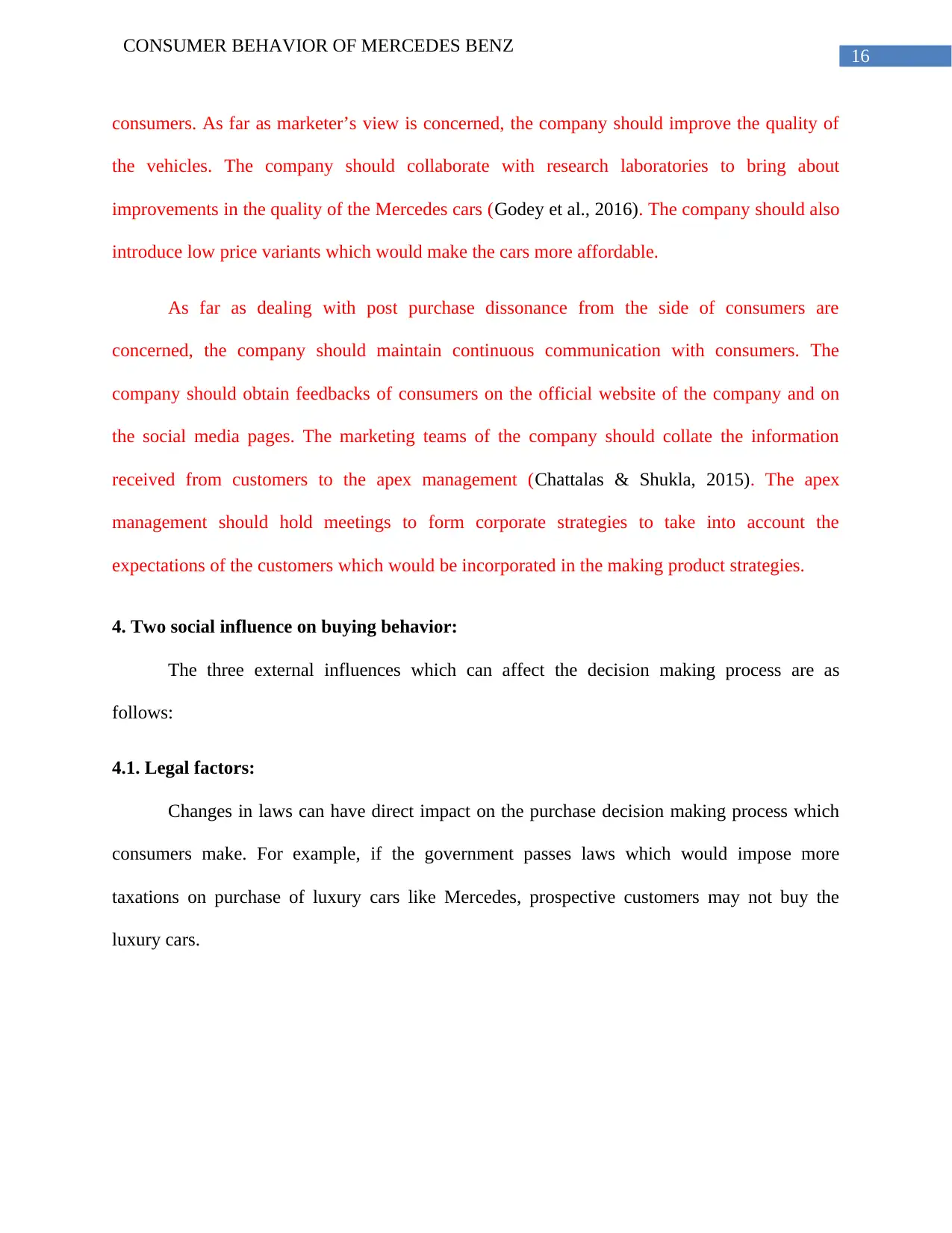
16
CONSUMER BEHAVIOR OF MERCEDES BENZ
consumers. As far as marketer’s view is concerned, the company should improve the quality of
the vehicles. The company should collaborate with research laboratories to bring about
improvements in the quality of the Mercedes cars (Godey et al., 2016). The company should also
introduce low price variants which would make the cars more affordable.
As far as dealing with post purchase dissonance from the side of consumers are
concerned, the company should maintain continuous communication with consumers. The
company should obtain feedbacks of consumers on the official website of the company and on
the social media pages. The marketing teams of the company should collate the information
received from customers to the apex management (Chattalas & Shukla, 2015). The apex
management should hold meetings to form corporate strategies to take into account the
expectations of the customers which would be incorporated in the making product strategies.
4. Two social influence on buying behavior:
The three external influences which can affect the decision making process are as
follows:
4.1. Legal factors:
Changes in laws can have direct impact on the purchase decision making process which
consumers make. For example, if the government passes laws which would impose more
taxations on purchase of luxury cars like Mercedes, prospective customers may not buy the
luxury cars.
CONSUMER BEHAVIOR OF MERCEDES BENZ
consumers. As far as marketer’s view is concerned, the company should improve the quality of
the vehicles. The company should collaborate with research laboratories to bring about
improvements in the quality of the Mercedes cars (Godey et al., 2016). The company should also
introduce low price variants which would make the cars more affordable.
As far as dealing with post purchase dissonance from the side of consumers are
concerned, the company should maintain continuous communication with consumers. The
company should obtain feedbacks of consumers on the official website of the company and on
the social media pages. The marketing teams of the company should collate the information
received from customers to the apex management (Chattalas & Shukla, 2015). The apex
management should hold meetings to form corporate strategies to take into account the
expectations of the customers which would be incorporated in the making product strategies.
4. Two social influence on buying behavior:
The three external influences which can affect the decision making process are as
follows:
4.1. Legal factors:
Changes in laws can have direct impact on the purchase decision making process which
consumers make. For example, if the government passes laws which would impose more
taxations on purchase of luxury cars like Mercedes, prospective customers may not buy the
luxury cars.
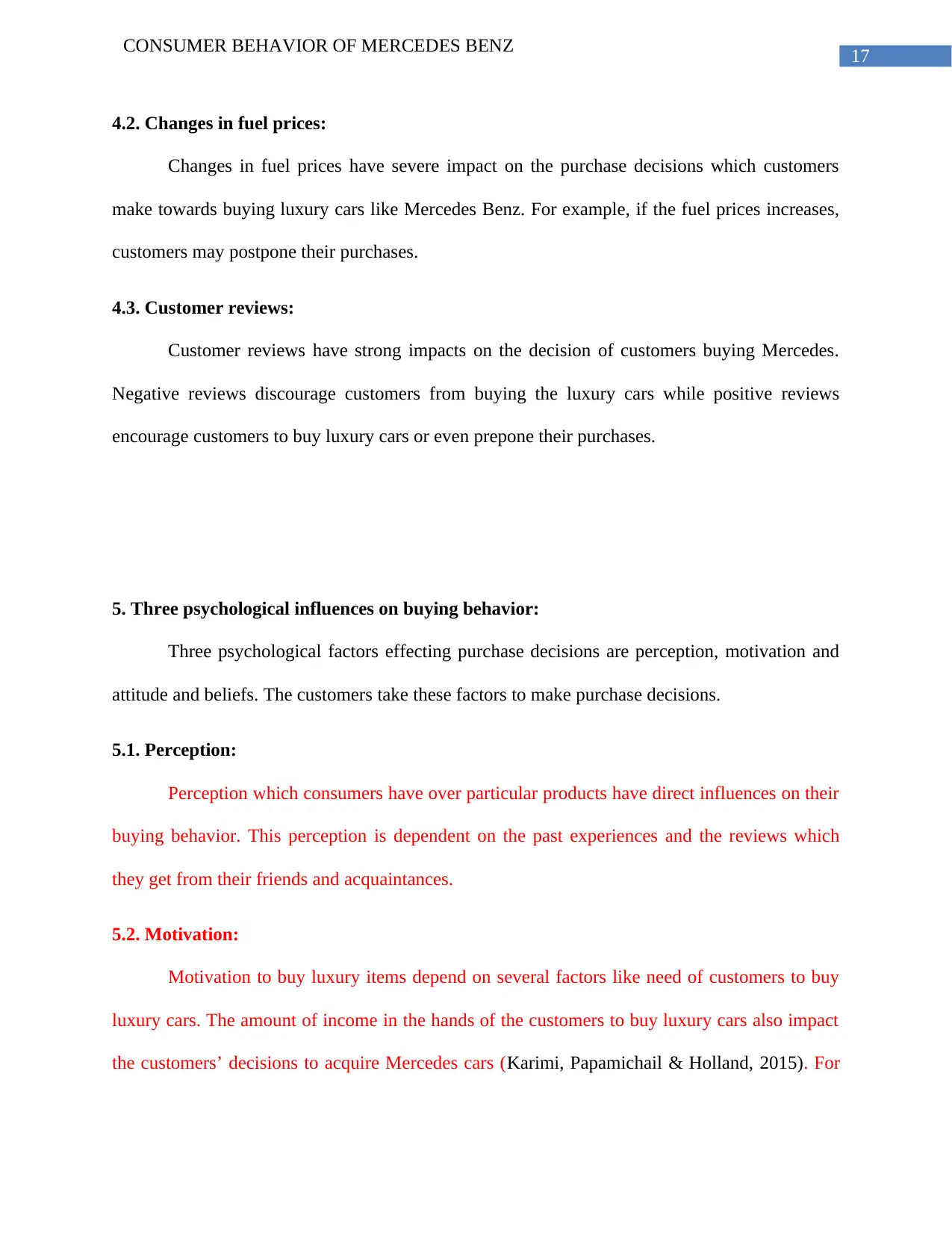
17
CONSUMER BEHAVIOR OF MERCEDES BENZ
4.2. Changes in fuel prices:
Changes in fuel prices have severe impact on the purchase decisions which customers
make towards buying luxury cars like Mercedes Benz. For example, if the fuel prices increases,
customers may postpone their purchases.
4.3. Customer reviews:
Customer reviews have strong impacts on the decision of customers buying Mercedes.
Negative reviews discourage customers from buying the luxury cars while positive reviews
encourage customers to buy luxury cars or even prepone their purchases.
5. Three psychological influences on buying behavior:
Three psychological factors effecting purchase decisions are perception, motivation and
attitude and beliefs. The customers take these factors to make purchase decisions.
5.1. Perception:
Perception which consumers have over particular products have direct influences on their
buying behavior. This perception is dependent on the past experiences and the reviews which
they get from their friends and acquaintances.
5.2. Motivation:
Motivation to buy luxury items depend on several factors like need of customers to buy
luxury cars. The amount of income in the hands of the customers to buy luxury cars also impact
the customers’ decisions to acquire Mercedes cars (Karimi, Papamichail & Holland, 2015). For
CONSUMER BEHAVIOR OF MERCEDES BENZ
4.2. Changes in fuel prices:
Changes in fuel prices have severe impact on the purchase decisions which customers
make towards buying luxury cars like Mercedes Benz. For example, if the fuel prices increases,
customers may postpone their purchases.
4.3. Customer reviews:
Customer reviews have strong impacts on the decision of customers buying Mercedes.
Negative reviews discourage customers from buying the luxury cars while positive reviews
encourage customers to buy luxury cars or even prepone their purchases.
5. Three psychological influences on buying behavior:
Three psychological factors effecting purchase decisions are perception, motivation and
attitude and beliefs. The customers take these factors to make purchase decisions.
5.1. Perception:
Perception which consumers have over particular products have direct influences on their
buying behavior. This perception is dependent on the past experiences and the reviews which
they get from their friends and acquaintances.
5.2. Motivation:
Motivation to buy luxury items depend on several factors like need of customers to buy
luxury cars. The amount of income in the hands of the customers to buy luxury cars also impact
the customers’ decisions to acquire Mercedes cars (Karimi, Papamichail & Holland, 2015). For
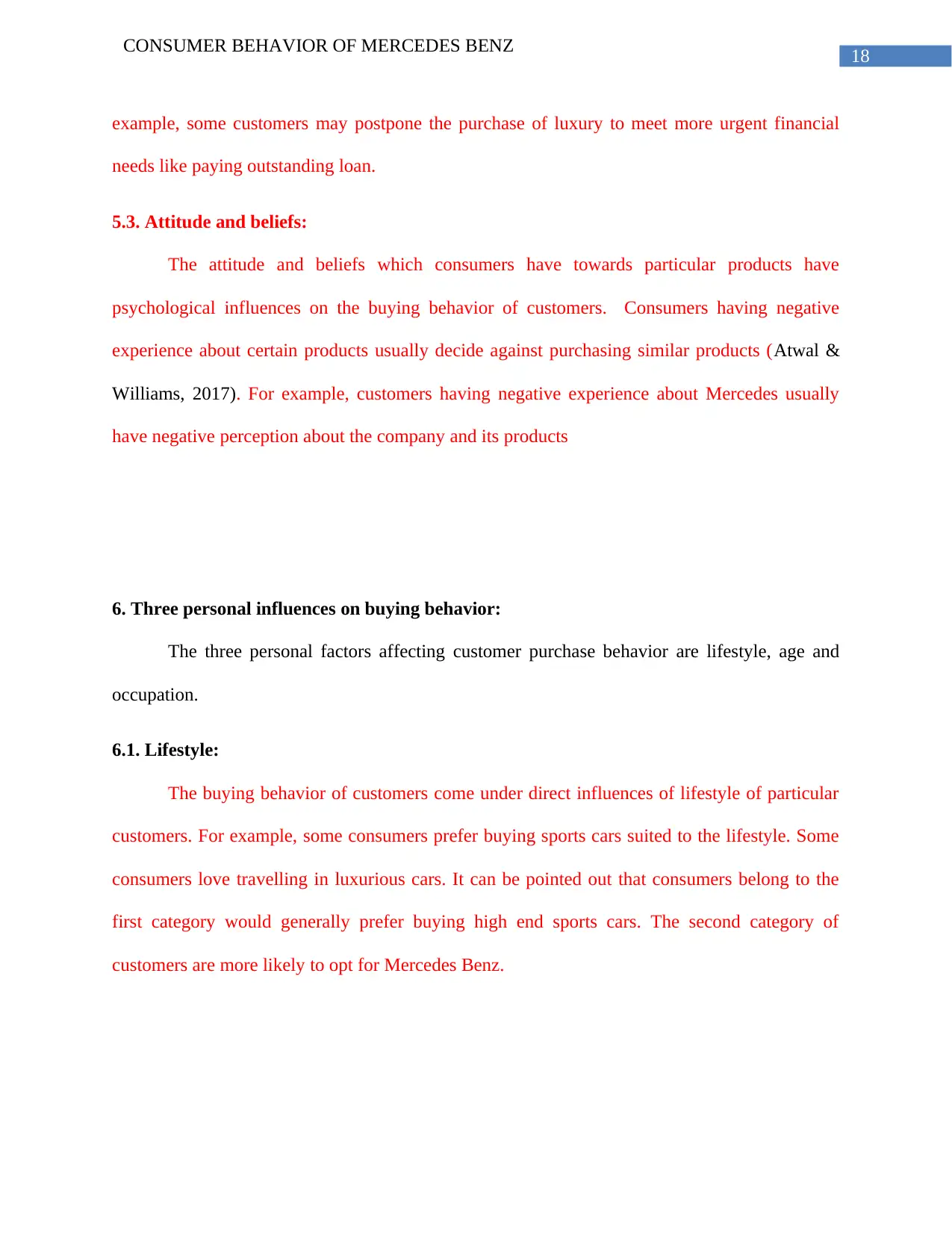
18
CONSUMER BEHAVIOR OF MERCEDES BENZ
example, some customers may postpone the purchase of luxury to meet more urgent financial
needs like paying outstanding loan.
5.3. Attitude and beliefs:
The attitude and beliefs which consumers have towards particular products have
psychological influences on the buying behavior of customers. Consumers having negative
experience about certain products usually decide against purchasing similar products (Atwal &
Williams, 2017). For example, customers having negative experience about Mercedes usually
have negative perception about the company and its products
6. Three personal influences on buying behavior:
The three personal factors affecting customer purchase behavior are lifestyle, age and
occupation.
6.1. Lifestyle:
The buying behavior of customers come under direct influences of lifestyle of particular
customers. For example, some consumers prefer buying sports cars suited to the lifestyle. Some
consumers love travelling in luxurious cars. It can be pointed out that consumers belong to the
first category would generally prefer buying high end sports cars. The second category of
customers are more likely to opt for Mercedes Benz.
CONSUMER BEHAVIOR OF MERCEDES BENZ
example, some customers may postpone the purchase of luxury to meet more urgent financial
needs like paying outstanding loan.
5.3. Attitude and beliefs:
The attitude and beliefs which consumers have towards particular products have
psychological influences on the buying behavior of customers. Consumers having negative
experience about certain products usually decide against purchasing similar products (Atwal &
Williams, 2017). For example, customers having negative experience about Mercedes usually
have negative perception about the company and its products
6. Three personal influences on buying behavior:
The three personal factors affecting customer purchase behavior are lifestyle, age and
occupation.
6.1. Lifestyle:
The buying behavior of customers come under direct influences of lifestyle of particular
customers. For example, some consumers prefer buying sports cars suited to the lifestyle. Some
consumers love travelling in luxurious cars. It can be pointed out that consumers belong to the
first category would generally prefer buying high end sports cars. The second category of
customers are more likely to opt for Mercedes Benz.
Paraphrase This Document
Need a fresh take? Get an instant paraphrase of this document with our AI Paraphraser
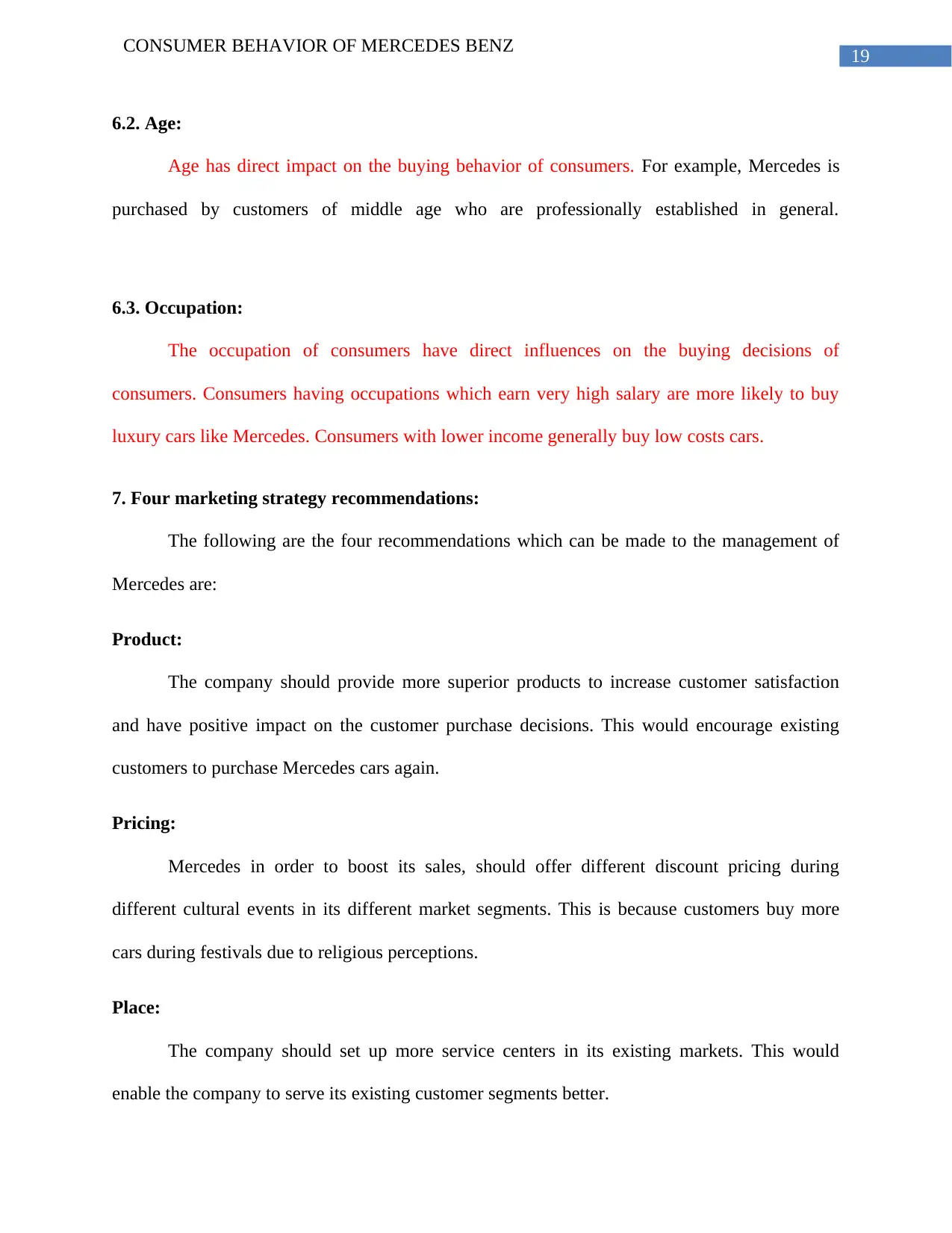
19
CONSUMER BEHAVIOR OF MERCEDES BENZ
6.2. Age:
Age has direct impact on the buying behavior of consumers. For example, Mercedes is
purchased by customers of middle age who are professionally established in general.
6.3. Occupation:
The occupation of consumers have direct influences on the buying decisions of
consumers. Consumers having occupations which earn very high salary are more likely to buy
luxury cars like Mercedes. Consumers with lower income generally buy low costs cars.
7. Four marketing strategy recommendations:
The following are the four recommendations which can be made to the management of
Mercedes are:
Product:
The company should provide more superior products to increase customer satisfaction
and have positive impact on the customer purchase decisions. This would encourage existing
customers to purchase Mercedes cars again.
Pricing:
Mercedes in order to boost its sales, should offer different discount pricing during
different cultural events in its different market segments. This is because customers buy more
cars during festivals due to religious perceptions.
Place:
The company should set up more service centers in its existing markets. This would
enable the company to serve its existing customer segments better.
CONSUMER BEHAVIOR OF MERCEDES BENZ
6.2. Age:
Age has direct impact on the buying behavior of consumers. For example, Mercedes is
purchased by customers of middle age who are professionally established in general.
6.3. Occupation:
The occupation of consumers have direct influences on the buying decisions of
consumers. Consumers having occupations which earn very high salary are more likely to buy
luxury cars like Mercedes. Consumers with lower income generally buy low costs cars.
7. Four marketing strategy recommendations:
The following are the four recommendations which can be made to the management of
Mercedes are:
Product:
The company should provide more superior products to increase customer satisfaction
and have positive impact on the customer purchase decisions. This would encourage existing
customers to purchase Mercedes cars again.
Pricing:
Mercedes in order to boost its sales, should offer different discount pricing during
different cultural events in its different market segments. This is because customers buy more
cars during festivals due to religious perceptions.
Place:
The company should set up more service centers in its existing markets. This would
enable the company to serve its existing customer segments better.
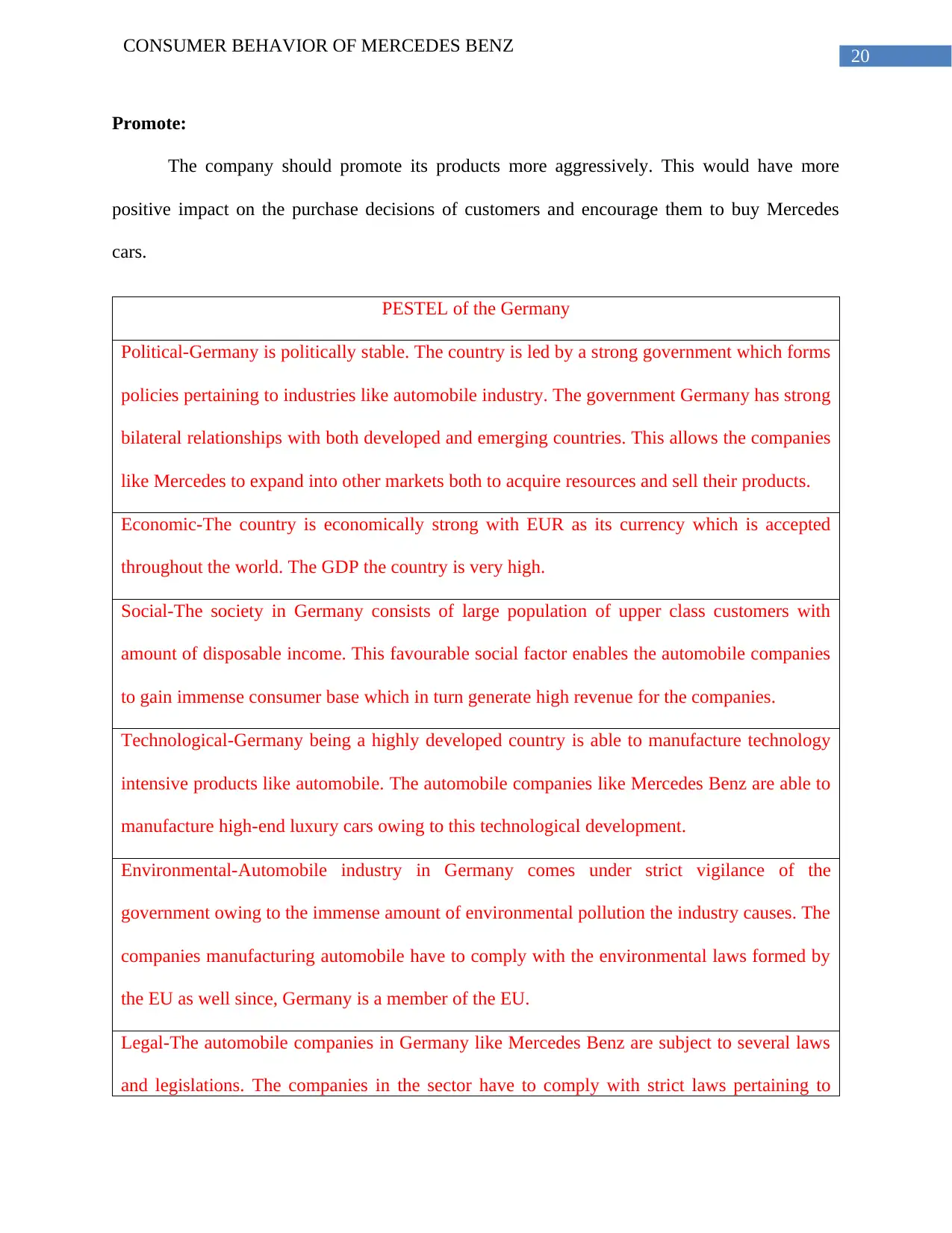
20
CONSUMER BEHAVIOR OF MERCEDES BENZ
Promote:
The company should promote its products more aggressively. This would have more
positive impact on the purchase decisions of customers and encourage them to buy Mercedes
cars.
PESTEL of the Germany
Political-Germany is politically stable. The country is led by a strong government which forms
policies pertaining to industries like automobile industry. The government Germany has strong
bilateral relationships with both developed and emerging countries. This allows the companies
like Mercedes to expand into other markets both to acquire resources and sell their products.
Economic-The country is economically strong with EUR as its currency which is accepted
throughout the world. The GDP the country is very high.
Social-The society in Germany consists of large population of upper class customers with
amount of disposable income. This favourable social factor enables the automobile companies
to gain immense consumer base which in turn generate high revenue for the companies.
Technological-Germany being a highly developed country is able to manufacture technology
intensive products like automobile. The automobile companies like Mercedes Benz are able to
manufacture high-end luxury cars owing to this technological development.
Environmental-Automobile industry in Germany comes under strict vigilance of the
government owing to the immense amount of environmental pollution the industry causes. The
companies manufacturing automobile have to comply with the environmental laws formed by
the EU as well since, Germany is a member of the EU.
Legal-The automobile companies in Germany like Mercedes Benz are subject to several laws
and legislations. The companies in the sector have to comply with strict laws pertaining to
CONSUMER BEHAVIOR OF MERCEDES BENZ
Promote:
The company should promote its products more aggressively. This would have more
positive impact on the purchase decisions of customers and encourage them to buy Mercedes
cars.
PESTEL of the Germany
Political-Germany is politically stable. The country is led by a strong government which forms
policies pertaining to industries like automobile industry. The government Germany has strong
bilateral relationships with both developed and emerging countries. This allows the companies
like Mercedes to expand into other markets both to acquire resources and sell their products.
Economic-The country is economically strong with EUR as its currency which is accepted
throughout the world. The GDP the country is very high.
Social-The society in Germany consists of large population of upper class customers with
amount of disposable income. This favourable social factor enables the automobile companies
to gain immense consumer base which in turn generate high revenue for the companies.
Technological-Germany being a highly developed country is able to manufacture technology
intensive products like automobile. The automobile companies like Mercedes Benz are able to
manufacture high-end luxury cars owing to this technological development.
Environmental-Automobile industry in Germany comes under strict vigilance of the
government owing to the immense amount of environmental pollution the industry causes. The
companies manufacturing automobile have to comply with the environmental laws formed by
the EU as well since, Germany is a member of the EU.
Legal-The automobile companies in Germany like Mercedes Benz are subject to several laws
and legislations. The companies in the sector have to comply with strict laws pertaining to

21
CONSUMER BEHAVIOR OF MERCEDES BENZ
areas like environment and exim.
SWOT analysis of Mercedes Benz
Strengths:
1. Global company.
2. Financially strong.
3. Immense consumer base.
Weakness:
1. Subject to environmental issues.
2. Subject to several negative customer
reviews.
3. Weak aftersales services.
Opportunities:
1. Expansion into new markets
2. Introduction of innovative low cost models.
Threats:
1. Stringent environmental laws.
2. Stiff market competition.
Conclusion:
It can be concluded from the discussion that Mercedes undoubtedly hold a high position
in the global market. However, the company is receiving negative reviews due to product quality
issue and after sales issue. The apex management should take steps to deal with these issues. The
company should take into account the various factors which influence the buying behavior of
consumers. The company should form strategies to form positive perceptions among consumers
to attract more consumers to buy Mercedes. This would enable the company acquire a bigger
base of customers which would yield higher revenue for the company.
CONSUMER BEHAVIOR OF MERCEDES BENZ
areas like environment and exim.
SWOT analysis of Mercedes Benz
Strengths:
1. Global company.
2. Financially strong.
3. Immense consumer base.
Weakness:
1. Subject to environmental issues.
2. Subject to several negative customer
reviews.
3. Weak aftersales services.
Opportunities:
1. Expansion into new markets
2. Introduction of innovative low cost models.
Threats:
1. Stringent environmental laws.
2. Stiff market competition.
Conclusion:
It can be concluded from the discussion that Mercedes undoubtedly hold a high position
in the global market. However, the company is receiving negative reviews due to product quality
issue and after sales issue. The apex management should take steps to deal with these issues. The
company should take into account the various factors which influence the buying behavior of
consumers. The company should form strategies to form positive perceptions among consumers
to attract more consumers to buy Mercedes. This would enable the company acquire a bigger
base of customers which would yield higher revenue for the company.
Secure Best Marks with AI Grader
Need help grading? Try our AI Grader for instant feedback on your assignments.
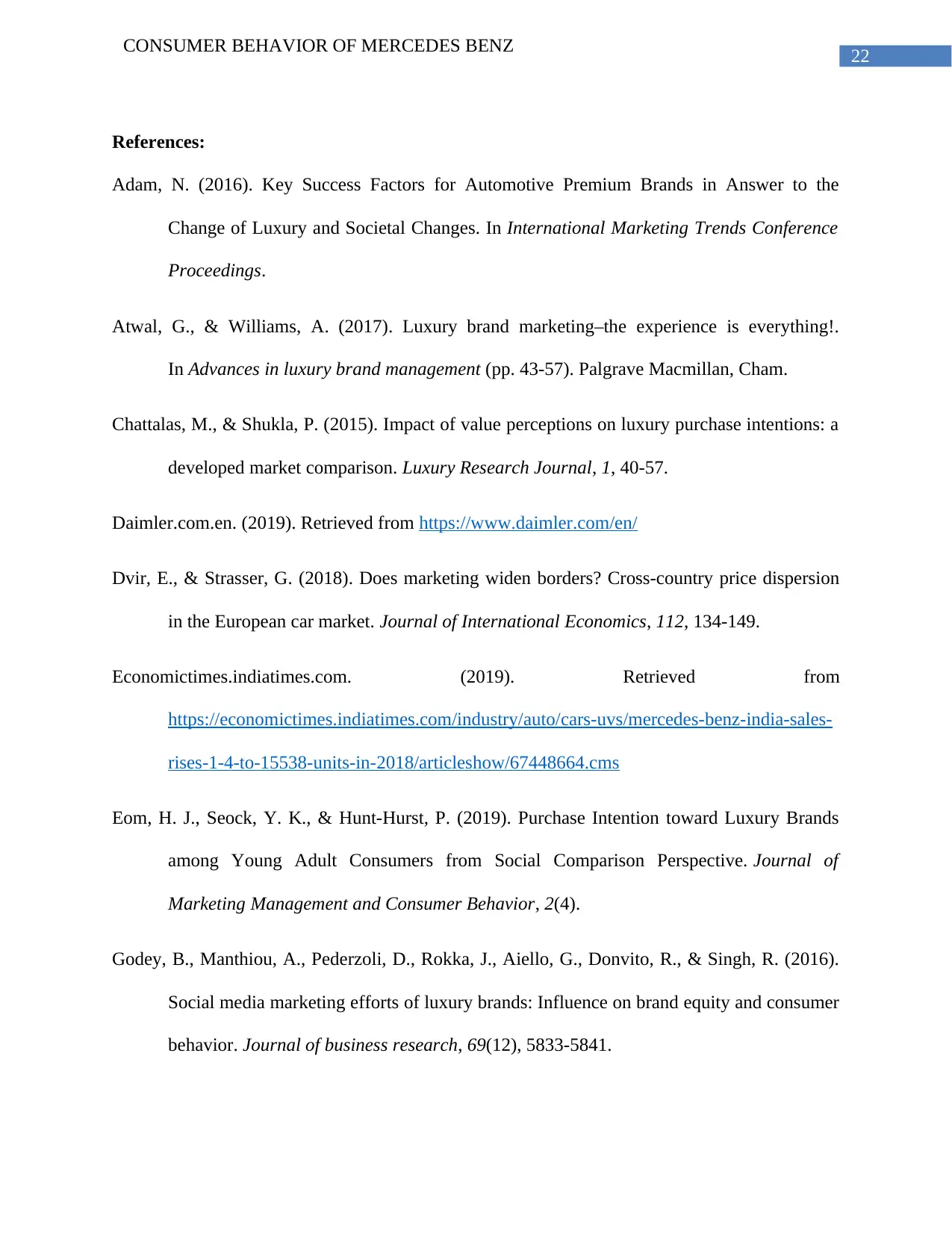
22
CONSUMER BEHAVIOR OF MERCEDES BENZ
References:
Adam, N. (2016). Key Success Factors for Automotive Premium Brands in Answer to the
Change of Luxury and Societal Changes. In International Marketing Trends Conference
Proceedings.
Atwal, G., & Williams, A. (2017). Luxury brand marketing–the experience is everything!.
In Advances in luxury brand management (pp. 43-57). Palgrave Macmillan, Cham.
Chattalas, M., & Shukla, P. (2015). Impact of value perceptions on luxury purchase intentions: a
developed market comparison. Luxury Research Journal, 1, 40-57.
Daimler.com.en. (2019). Retrieved from https://www.daimler.com/en/
Dvir, E., & Strasser, G. (2018). Does marketing widen borders? Cross-country price dispersion
in the European car market. Journal of International Economics, 112, 134-149.
Economictimes.indiatimes.com. (2019). Retrieved from
https://economictimes.indiatimes.com/industry/auto/cars-uvs/mercedes-benz-india-sales-
rises-1-4-to-15538-units-in-2018/articleshow/67448664.cms
Eom, H. J., Seock, Y. K., & Hunt-Hurst, P. (2019). Purchase Intention toward Luxury Brands
among Young Adult Consumers from Social Comparison Perspective. Journal of
Marketing Management and Consumer Behavior, 2(4).
Godey, B., Manthiou, A., Pederzoli, D., Rokka, J., Aiello, G., Donvito, R., & Singh, R. (2016).
Social media marketing efforts of luxury brands: Influence on brand equity and consumer
behavior. Journal of business research, 69(12), 5833-5841.
CONSUMER BEHAVIOR OF MERCEDES BENZ
References:
Adam, N. (2016). Key Success Factors for Automotive Premium Brands in Answer to the
Change of Luxury and Societal Changes. In International Marketing Trends Conference
Proceedings.
Atwal, G., & Williams, A. (2017). Luxury brand marketing–the experience is everything!.
In Advances in luxury brand management (pp. 43-57). Palgrave Macmillan, Cham.
Chattalas, M., & Shukla, P. (2015). Impact of value perceptions on luxury purchase intentions: a
developed market comparison. Luxury Research Journal, 1, 40-57.
Daimler.com.en. (2019). Retrieved from https://www.daimler.com/en/
Dvir, E., & Strasser, G. (2018). Does marketing widen borders? Cross-country price dispersion
in the European car market. Journal of International Economics, 112, 134-149.
Economictimes.indiatimes.com. (2019). Retrieved from
https://economictimes.indiatimes.com/industry/auto/cars-uvs/mercedes-benz-india-sales-
rises-1-4-to-15538-units-in-2018/articleshow/67448664.cms
Eom, H. J., Seock, Y. K., & Hunt-Hurst, P. (2019). Purchase Intention toward Luxury Brands
among Young Adult Consumers from Social Comparison Perspective. Journal of
Marketing Management and Consumer Behavior, 2(4).
Godey, B., Manthiou, A., Pederzoli, D., Rokka, J., Aiello, G., Donvito, R., & Singh, R. (2016).
Social media marketing efforts of luxury brands: Influence on brand equity and consumer
behavior. Journal of business research, 69(12), 5833-5841.
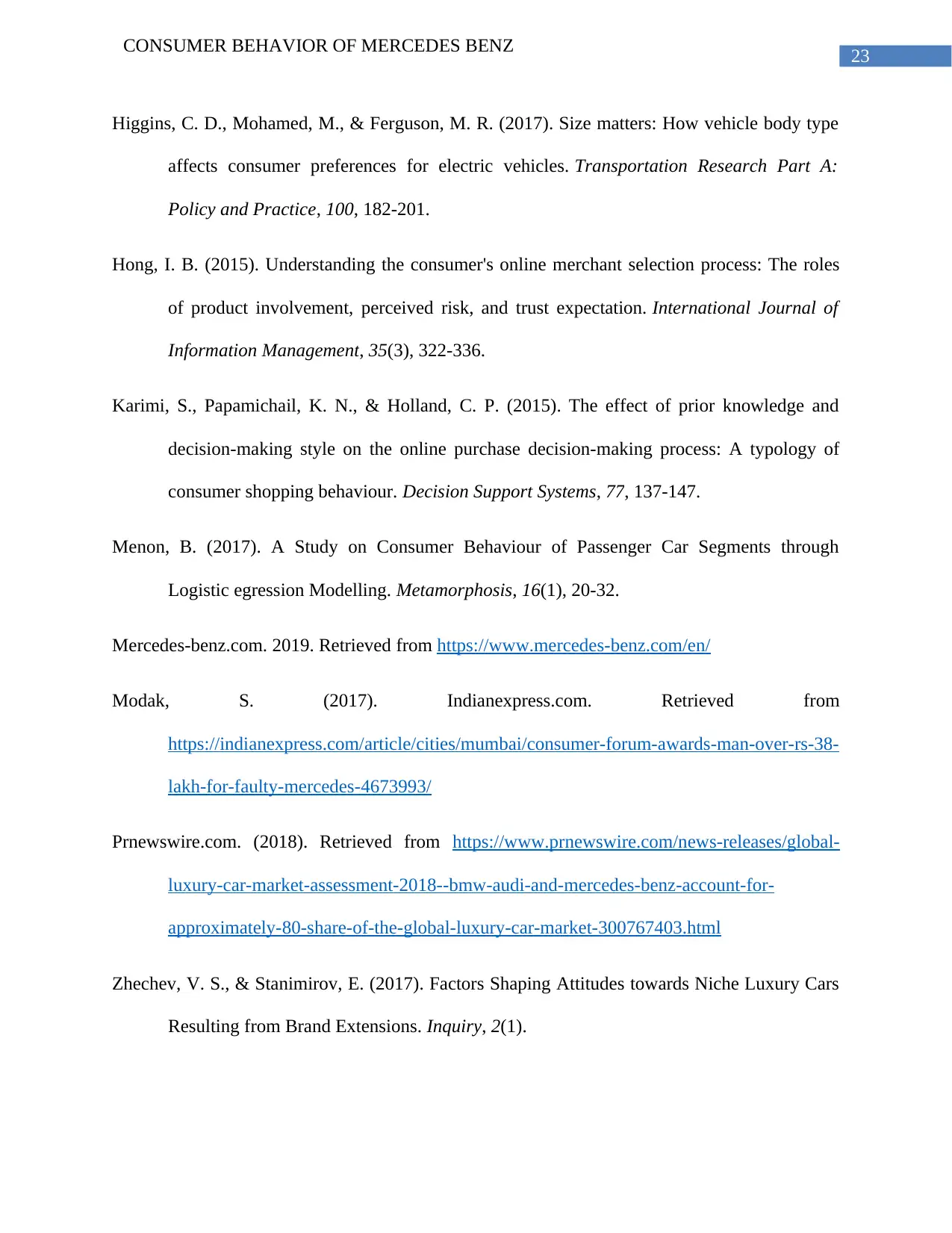
23
CONSUMER BEHAVIOR OF MERCEDES BENZ
Higgins, C. D., Mohamed, M., & Ferguson, M. R. (2017). Size matters: How vehicle body type
affects consumer preferences for electric vehicles. Transportation Research Part A:
Policy and Practice, 100, 182-201.
Hong, I. B. (2015). Understanding the consumer's online merchant selection process: The roles
of product involvement, perceived risk, and trust expectation. International Journal of
Information Management, 35(3), 322-336.
Karimi, S., Papamichail, K. N., & Holland, C. P. (2015). The effect of prior knowledge and
decision-making style on the online purchase decision-making process: A typology of
consumer shopping behaviour. Decision Support Systems, 77, 137-147.
Menon, B. (2017). A Study on Consumer Behaviour of Passenger Car Segments through
Logistic egression Modelling. Metamorphosis, 16(1), 20-32.
Mercedes-benz.com. 2019. Retrieved from https://www.mercedes-benz.com/en/
Modak, S. (2017). Indianexpress.com. Retrieved from
https://indianexpress.com/article/cities/mumbai/consumer-forum-awards-man-over-rs-38-
lakh-for-faulty-mercedes-4673993/
Prnewswire.com. (2018). Retrieved from https://www.prnewswire.com/news-releases/global-
luxury-car-market-assessment-2018--bmw-audi-and-mercedes-benz-account-for-
approximately-80-share-of-the-global-luxury-car-market-300767403.html
Zhechev, V. S., & Stanimirov, E. (2017). Factors Shaping Attitudes towards Niche Luxury Cars
Resulting from Brand Extensions. Inquiry, 2(1).
CONSUMER BEHAVIOR OF MERCEDES BENZ
Higgins, C. D., Mohamed, M., & Ferguson, M. R. (2017). Size matters: How vehicle body type
affects consumer preferences for electric vehicles. Transportation Research Part A:
Policy and Practice, 100, 182-201.
Hong, I. B. (2015). Understanding the consumer's online merchant selection process: The roles
of product involvement, perceived risk, and trust expectation. International Journal of
Information Management, 35(3), 322-336.
Karimi, S., Papamichail, K. N., & Holland, C. P. (2015). The effect of prior knowledge and
decision-making style on the online purchase decision-making process: A typology of
consumer shopping behaviour. Decision Support Systems, 77, 137-147.
Menon, B. (2017). A Study on Consumer Behaviour of Passenger Car Segments through
Logistic egression Modelling. Metamorphosis, 16(1), 20-32.
Mercedes-benz.com. 2019. Retrieved from https://www.mercedes-benz.com/en/
Modak, S. (2017). Indianexpress.com. Retrieved from
https://indianexpress.com/article/cities/mumbai/consumer-forum-awards-man-over-rs-38-
lakh-for-faulty-mercedes-4673993/
Prnewswire.com. (2018). Retrieved from https://www.prnewswire.com/news-releases/global-
luxury-car-market-assessment-2018--bmw-audi-and-mercedes-benz-account-for-
approximately-80-share-of-the-global-luxury-car-market-300767403.html
Zhechev, V. S., & Stanimirov, E. (2017). Factors Shaping Attitudes towards Niche Luxury Cars
Resulting from Brand Extensions. Inquiry, 2(1).
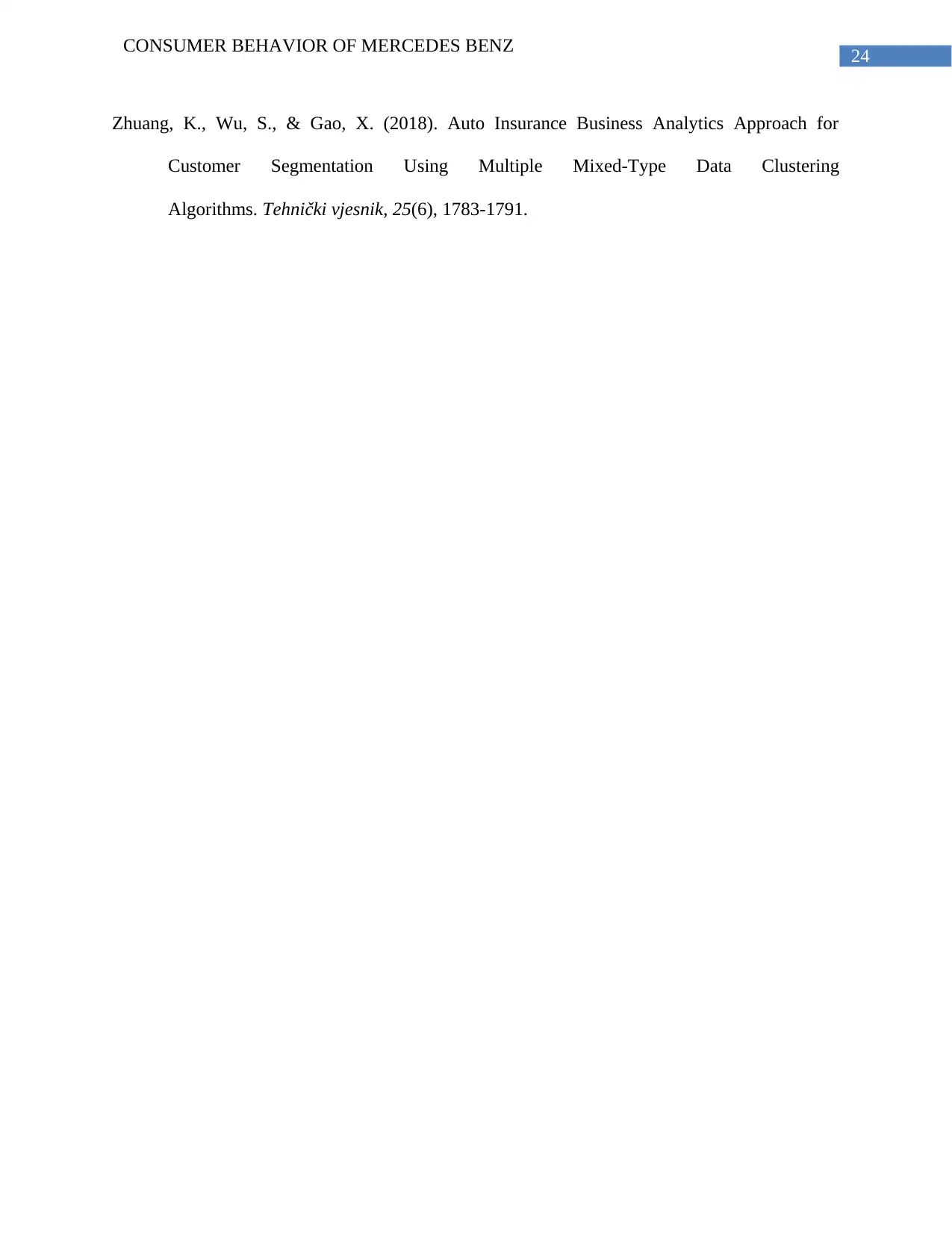
24
CONSUMER BEHAVIOR OF MERCEDES BENZ
Zhuang, K., Wu, S., & Gao, X. (2018). Auto Insurance Business Analytics Approach for
Customer Segmentation Using Multiple Mixed-Type Data Clustering
Algorithms. Tehnički vjesnik, 25(6), 1783-1791.
CONSUMER BEHAVIOR OF MERCEDES BENZ
Zhuang, K., Wu, S., & Gao, X. (2018). Auto Insurance Business Analytics Approach for
Customer Segmentation Using Multiple Mixed-Type Data Clustering
Algorithms. Tehnički vjesnik, 25(6), 1783-1791.
1 out of 25
Related Documents
Your All-in-One AI-Powered Toolkit for Academic Success.
+13062052269
info@desklib.com
Available 24*7 on WhatsApp / Email
![[object Object]](/_next/static/media/star-bottom.7253800d.svg)
Unlock your academic potential
© 2024 | Zucol Services PVT LTD | All rights reserved.





